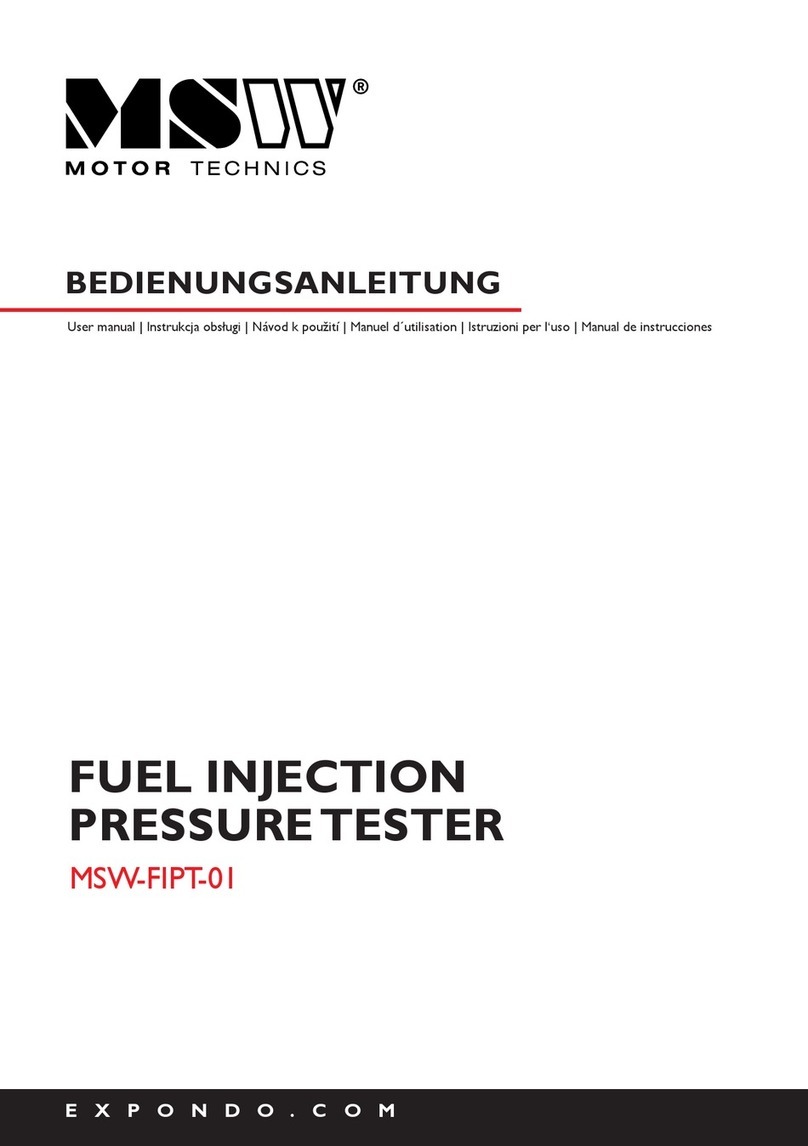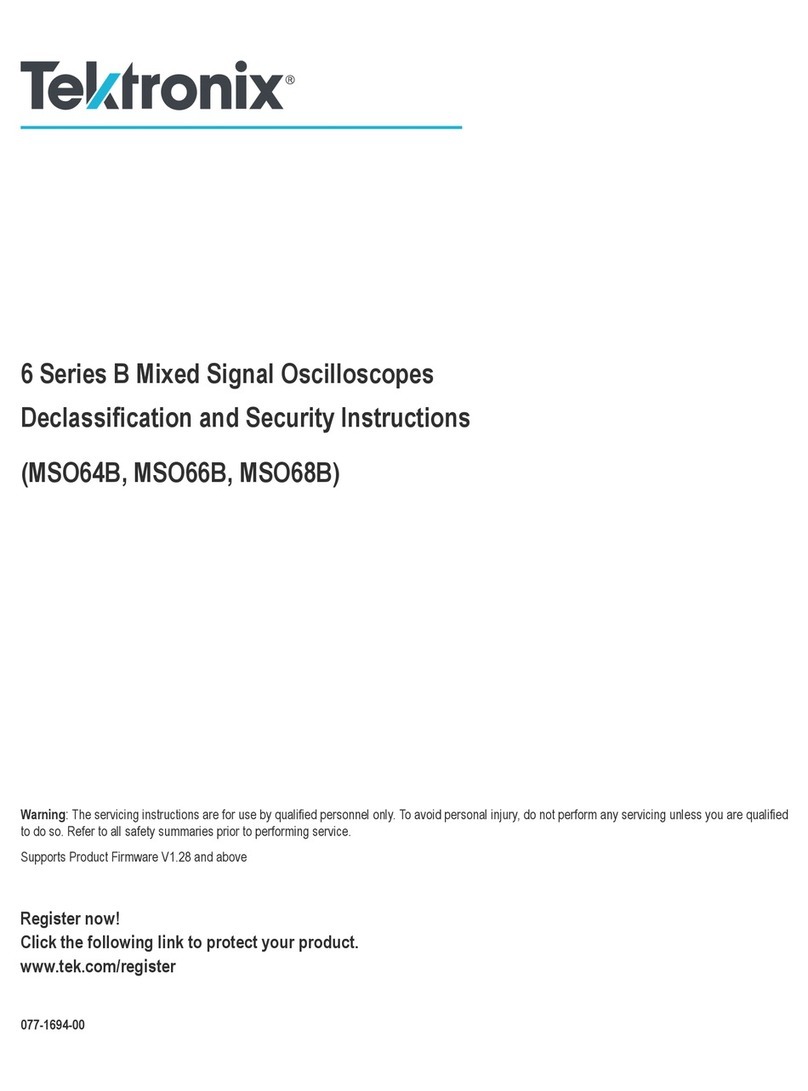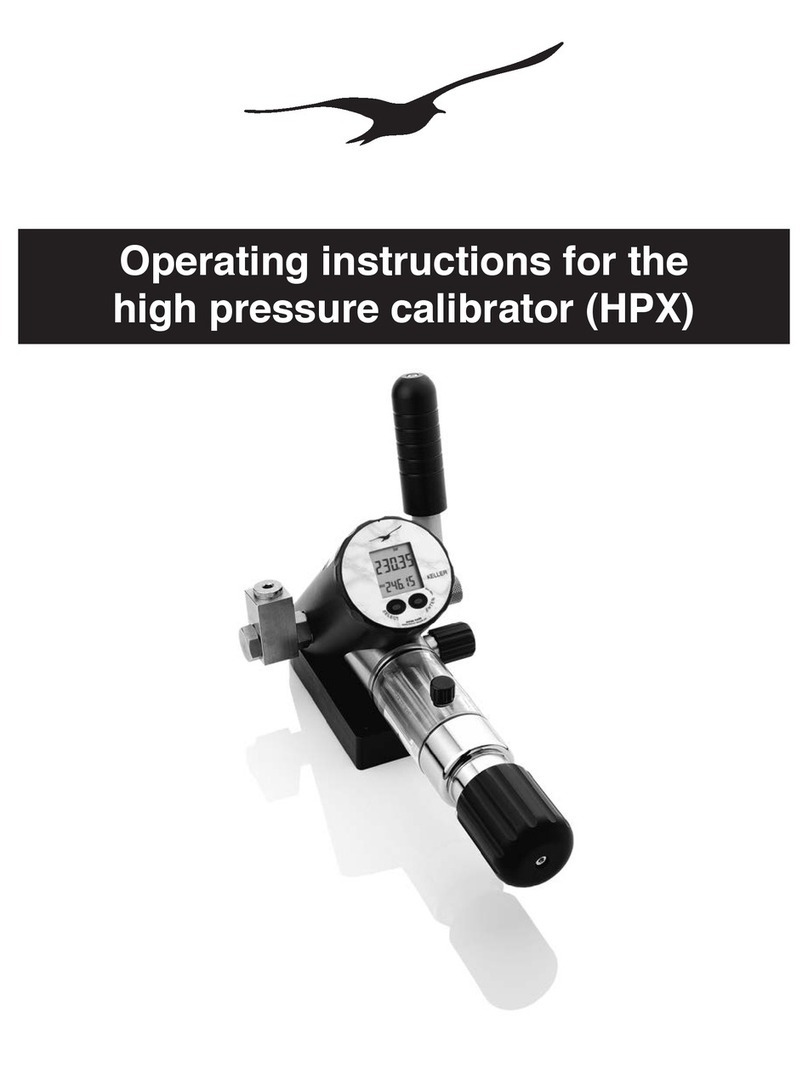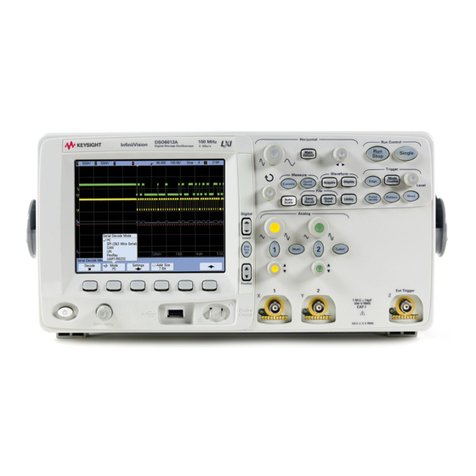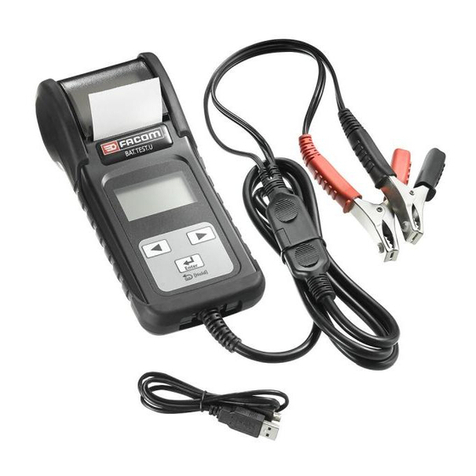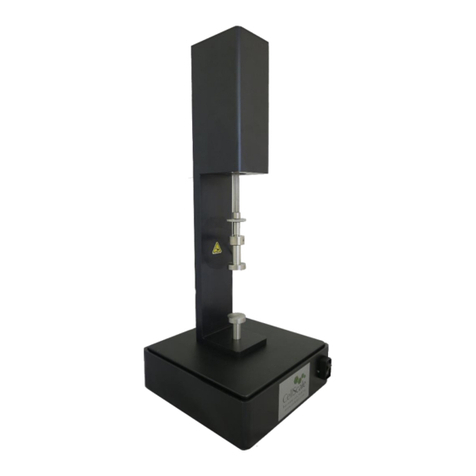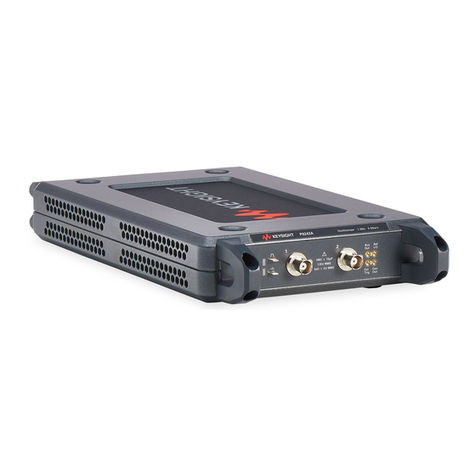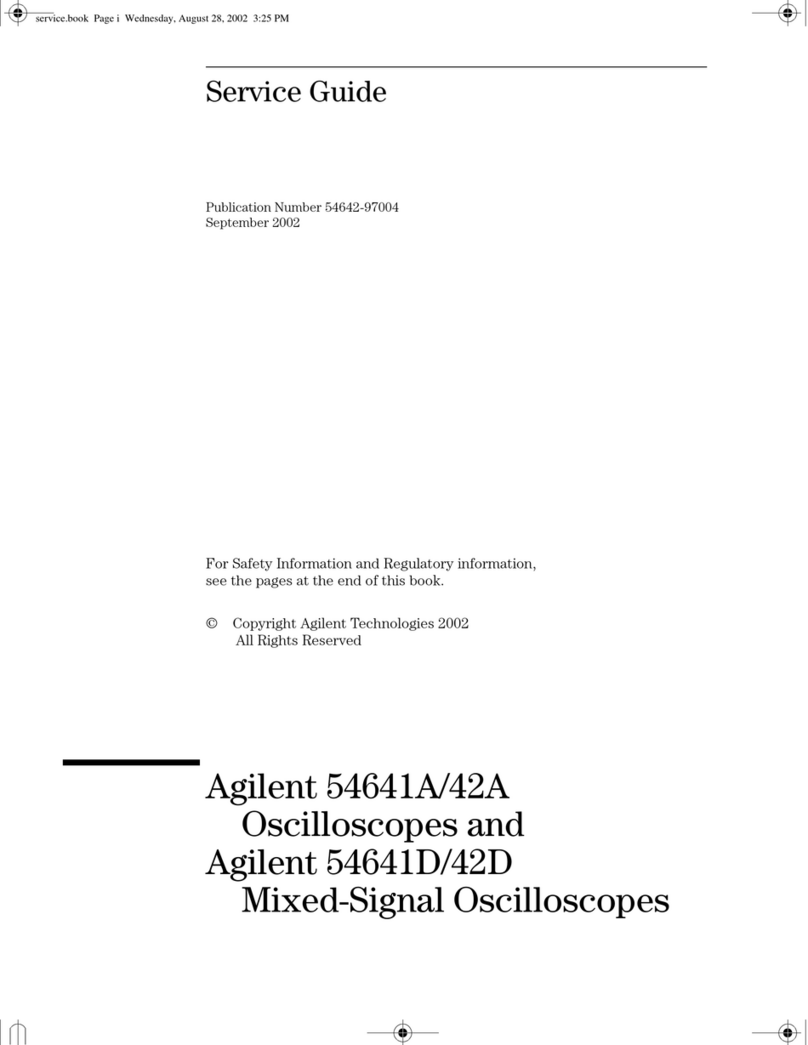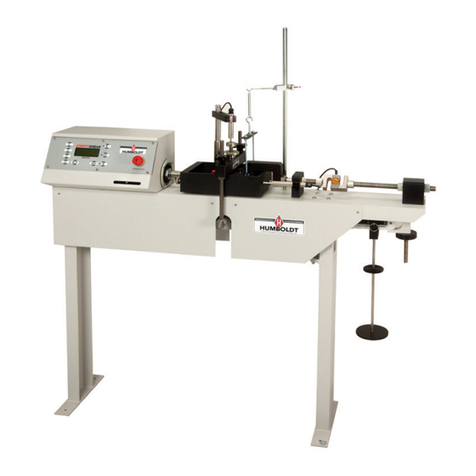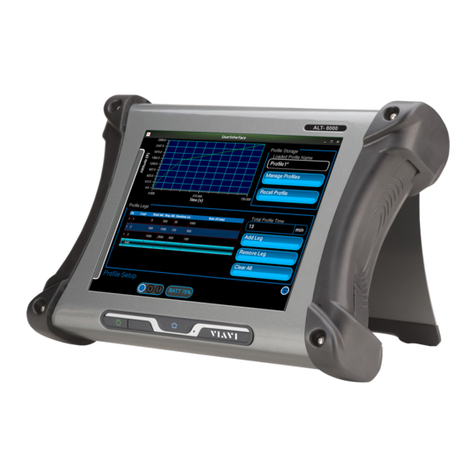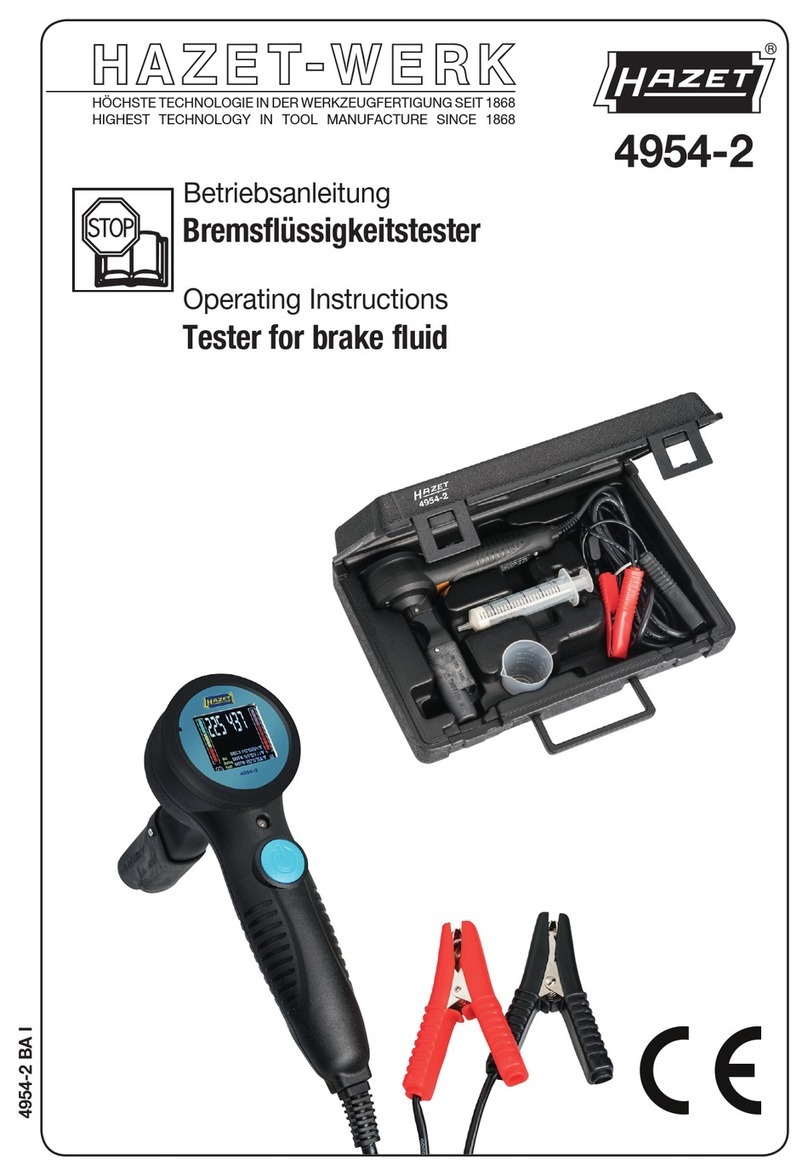MSW Motor Technics MSW-BLT-100A User manual

EXPONDO.DE
BATTERY CHARGE TESTER
MSW-BLT-100A
BEDIENUNGSANLEITUNG
User manual | Instrukcja obsługi | Návod k použití | Manuel d´utilisation | Istruzioni per l‘uso | Manual de instrucciones

Rev. 06.02.2020 3
Rev. 06.02.2020
2
Rev. 06.02.2020
2
Deutsch
English
Polski
Česky
Français
Italiano
Español
3
7
10
14
17
21
24
INHALT | CONTENT | TREŚĆ | OBSAH | CONTENU | CONTENUTO | CONTENIDO
PRODUKTNAME BATTERIELADUNGSTESTER
PRODUCT NAME BATTERY CHARGE TESTER
NAZWA PRODUKTU TESTER ŁADOWANIA AKUMULATORA
NÁZEV VÝROBKU TESTER NAPĚTÍ AUTOBATERIE A NABÍJECÍHO SYSTÉMU
NOM DU PRODUIT TESTEUR DE CHARGE DE BATTERIE
NOME DEL PRODOTTO TESTER STATO DELLA BATTERIA
NOMBRE DEL PRODUCTO COMPROBADOR DE CARGA DE BATERÍAS
MODELL
MSW-BLT-100A
PRODUCT MODEL
MODEL PRODUKTU
MODEL VÝROBKU
MODÈLE
MODELLO
MODELO
IMPORTEUR
EXPONDO POLSKA SP. Z O.O. SP. K.
IMPORTER
IMPORTER
DOVOZCE
IMPORTATEUR
IMPORTATORE
IMPORTADOR
ADRESSE VON IMPORTEUR
UL. NOWY KISIELIN-INNOWACYJNA 7, 66-002 ZIELONA GÓRA | POLAND, EU
IMPORTER ADDRESS
ADRES IMPORTERA
ADRESA DOVOZCE
ADRESSE DE L'IMPORTATEUR
INDIRIZZO DELL'IMPORTATORE
DIRECCIÓN DEL IMPORTADOR
TECHNISCHE DATEN
2.1. ELEKTRISCHE SICHERHEIT
a) Berühren Sie das Gerät nicht mit nassen oder
feuchten Händen.
b) ACHTUNG LEBENSGEFAHR! Tauchen und Halten Sie
das Gerät während des Reinigens oder des Betriebes
nie in Wasser oder andere Flüssigkeiten.
2.2. SICHERHEIT AM ARBEITSPLATZ
a) Halten Sie Ihren Arbeitsplatz sauber und
gut beleuchtet. Unordnung oder schlechte
Beleuchtung kann zu Unfällen führen. Handeln Sie
vorausschauend, beobachten Sie, was getan wird,
und nutzen Sie Ihren gesunden Menschenverstand
bei der Verwendung des Gerätes.
b) BenutzenSiedasGerätnichtinexplosionsgefährdeten
Bereichen, zum Beispiel in Gegenwart von
brennbaren Flüssigkeiten, Gasen oder Staub. Geräte
können unter Umständen Funken erzeugen, welche
Staub oder Dämpfe entzünden können.
c) Bei Zweifeln, ob das Produkt ordnungsgemäß
funktioniert, oder wenn Schäden festgestellt werden,
wenden Sie sich bitte an den Kundendienst des
Herstellers.
d) Das Produkt darf nur vom Hersteller repariert
werden. Reparieren Sie es nicht selbst!
e) Zum Löschen des Gerätes bei Brand oder Feuer, nur
Pulverfeuerlöscher oder Kohlendioxidlöscher (CO2)
verwenden.
f) Halten Sie Kinder und Unbefugte fern; Unachtsamkeit
kann zum Verlust der Kontrolle über das Gerät
führen.
g) Verwenden Sie das Gerät in einem gut belüfteten
Bereich.
h) Überprüfen Sie regelmäßig den Zustand der
Sicherheitsinformationsaufkleber. Falls die Aufkleber
unleserlich sind, sollten diese erneuert werden.
i) Bewahren Sie die Gebrauchsanleitung für
den weiteren Gebrauch auf. Sollte das Gerät
an Dritte weitergegeben werden, muss die
Gebrauchsanleitung mit ausgehändigt werden.
j) Verpackungselemente und kleine Montageteile
außerhalb der Reichweite von Kindern aufbewahren.
k) Halten Sie das Gerät von Kindern und Tieren fern.
l) Im Laufe der Nutzung dieses Werkzeugs
einschlieβlich anderer Werkzeuge soll man sich nach
übrigen Betriebsanweisungen richten.
Parameter Werte
Produktname Batterieladungstester
Modell MSW-BLT-100A
Schutzklasse III
Schutzart IP IPX0
Abmessungen [mm] 282 x 153 x 68
Gewicht [kg] 0,84
Typ der unterstützten
Batterien
Blei-Säure (einschließlich
EFB und AGM), 6 / 12 V
Ladestrom-Testbereich [A] 100 (500 ~1000 CCA)
Unterstützter Batterieka-
pazitätsbereich [Ah] 32 – 500
Start-Test Für 12V Batterien
Testzeit/Intervall
10s/1 min
Pause-Kühlprozess
(3 Tests/5 Minuten)
Das Produkt erfüllt die geltenden
Sicherheitsnormen.
Gebrauchsanweisung beachten.
Recyclingprodukt.
ACHTUNG!, WARNUNG! oder HINWEIS!, um auf
bestimmte Umstände aufmerksam zu machen
(allgemeines Warnzeichen).
Augenschutz benutzen.
Handschutz benutzen.
ACHTUNG! Heiße Fläche. Verbrennungsgefahr!
Die Begrie "Gerät" oder "Produkt" in den Warnungen
und Beschreibung des Handbuchs beziehen sich auf
BATTERIELADUNGSTESTER. Benutzen Sie das Gerät
nicht in Räumen mit sehr hoher Luftfeuchtigkeit oder in
unmittelbarer Nähe von Wasserbehältern! Lassen Sie das
Gerät nicht nass werden. Gefahr eines elektrischen Schlags!
Die Ventilationsönungen dürfen nicht verdeckt werden!
1. ALLGEMEINE BESCHREIBUNG
Diese Anleitung ist als Hilfe bei der sicheren und
zuverlässigen Nutzung gedacht. Das Produkt wurde strikt
nach den technischen Vorgaben und unter Verwendung
modernster Technologien und Komponenten sowie unter
Wahrung der höchsten Qualitätsstandards entworfen und
angefertigt.
VOR INBETRIEBNAHME MUSS DIE ANLEITUNG
GENAU DURCHGELESEN
UND VERSTANDEN WERDEN.
Für einen langen und zuverlässigen Betrieb des Geräts muss
auf die richtige Handhabung und Wartung entsprechend
den in dieser Anleitung angeführten Vorgaben geachtet
werden. Die in dieser Anleitung angegebenen technischen
Daten und die Spezikation sind aktuell. Der Hersteller
behält sich das Recht vor, im Rahmen der Verbesserung der
Qualität Änderungen vorzunehmen.
ERLÄUTERUNG DER SYMBOLE
HINWEIS! In der vorliegenden Anleitung sind
Beispielbilder vorhanden, die von dem tatsächlichen
Aussehen der Produkt abweichen können.
Die originale Anweisung ist die deutschsprachige Fassung.
Sonstige Sprachfassungen sind Übersetzungen aus der
deutschen Sprache.
2. NUTZUNGSBEDINGUNGEN
ACHTUNG! Lesen Sie alle Sicherheitshinweise und
alle Anweisungen durch. Die Nichtbeachtung der
Warnungen und Anweisungen kann zu elektrischen
Schlägen, Feuer und/oder schweren Verletzungen
oder Tod führen.
HINWEIS! Kinder und Unbeteiligte müssen bei der
Arbeit mit diesem Gerät gesichert werden.
2.3. PERSÖNLICHE SICHERHEIT
a) Es ist nicht gestattet, das Gerät im Zustand der
Ermüdung, Krankheit, unter Einuss von Alkohol,
Drogen oder Medikamenten zu betreiben, wenn das
die Fähigkeit das Gerät zu bedienen, einschränkt.
DE
BEDIENUNGSANLEITUNG

4Rev. 06.02.2020 5
Rev. 06.02.2020
3. NUTZUNGSBEDINGUNGEN
Das Gerät ist bestimmt für:
• Prüfung des Zustands von Blei-Säure-Batterien
(einschließlich EFB und AGM) 6/12 V;
• Prüfung des Zustands von Lichtmaschinen und
Anlassern in Fahrzeugen.
Für alle Schäden bei nicht sachgemäßer Verwendung
haftet allein der Betreiber.
3.1. GERÄTEBESCHREIBUNG
1
2
4
5
3
1. Gri
2. Messgerät
3. EIN/ AUS-Schalter (Test)
4. Klemme für Pluspol (rot)
5. Klemme für Minuspol (schwarz)
Denition der Anzeigen des Messgeräts:
Belastungstest /
15 Sekunden
(Anzeigen bzw.
Meldungen)
Denition des Akkuzustands
„OK”
(grünes Feld)
Möglicherweise ist die
Batteriekapazität ausreichend
oder der Akku ist nicht vollständig
aufgeladen. Es wird empfohlen,
zusätzlich die Elektrolytdichte in der
Batterie zu überprüfen - mit einem
Hydrometer/Aerometer (nicht im
Lieferumfang enthalten). Wenn die
Elektrolytdichte unter dem vollen
Ladezustand liegt, überprüfen Sie das
Ladesystem auf Defekte.
„WEAK”
(gelbes Feld)
Wenn der Zeiger des Messgeräts
ohne Schwankungen einen stabilen
Wert anzeigt, ist die Batteriekapazität
unzureichend. Überprüfen Sie den
Elektrolytstatus der Batterie:
Bei mehr als 1,225 ist der Akku
beschädigt. Liegt der Wert unter
1,225, laden Sie den Akku auf und
wiederholen Sie den Test. Wenn
der Unterschied zwischen einzelnen
Zellen mehr als 2 Punkte (0,025)
beträgt, ist die Zelle möglicherweise
beschädigt. Wenn das Auaden der
Batterie den Elektrolytstand nicht
vollständig auädt, bedeutet dies,
dass die Batterie sulfatiert ist oder
aktives Material verloren hat.
„BAD”
(rotes Feld)
Wenn der Zeiger des Messgeräts
abfällt, ist die Batterie defekt oder
die Zelle ist beschädigt. Um dies
schnell zu überprüfen, lassen Sie die
EIN / AUS-Taste los und beobachten
Sie die Reaktion des Zeigers. Wenn
die Spannung nach weniger als ein
paar Sekunden wieder auf ihr volles
Potential zurückkehrt, ist der Akku
höchstwahrscheinlich beschädigt.
Wenn sich die Spannung langsam
aufbaut, ist der Akku wahrscheinlich
nicht vollständig aufgeladen.
Überprüfen Sie den Stand des
Elektrolyts, laden Sie den Akku auf
und wiederholen Sie den Test.
„CHARGING
SYSTEM”
(Lichtmaschi-
nentest)
Wenn der Zeiger während des Tests im
grünen Feld (OK) bleibt, funktioniert
das Ladesystem ordnungsgemäß.
Wenn der Zeiger über/unter das
grüne Feld fällt, funktioniert das
Ladesystem nicht richtig
3.2. VORBEREITUNG ZUR VERWENDUNG
ARBEITSPLATZ DES GERÄTES:
Stellen Sie das Gerät so auf, dass eine gute Luftzirkulation
gewährleistet ist. Halten Sie das Gerät von heißen Flächen
fern. Das Gerät sollte immer auf einer ebenen, stabilen,
sauberen, feuerfesten und trockenen Oberäche und
außerhalb der Reichweite von Kindern und Personen mit
eingeschränkten geistigen, sensorischen und psychischen
Fähigkeiten verwendet werden.
3.3. ARBEIT MIT DEM GERÄT
3.3.1 AKKUTEST
A. Um eine gute Verbindung mit dem Gerät zu
gewährleisten, wird es empfohlen, die Akkukontakte
zuerst mit einem trockenen Tuch oder einem Lappen
zu reinigen, um Anlauarben zu entfernen.
B. Verbinden Sie die rote Klemme mit dem Pluspol
(+) der Batterie und die schwarze Klemme mit dem
Minuspol (-).
C. Wenn die Klemmen richtig angeschlossen sind, zeigt
das Gerät die aktuelle Batteriespannung auf dem
Display an.
ACHTUNG! Liegt die angezeigte Spannung unter
12 V, soll der Akku vor weiteren Tests aufgeladen
werden. Liegt der angezeigte Spannungswert nach
dem Laden immer noch unter 12 V, ist der Akku
defekt. Wenn nichts angezeigt wird, überprüfen Sie
den korrekten Anschluss des Geräts an den Akku.
D. Halten Sie den EIN / AUS-Schalter mindestens 5
Sekunden lang gedrückt, um die Batterieladung zu
simulieren. Lesen Sie den angezeigten Wert auf dem
Display ab und vergleichen Sie den Wert mit der
Wertedenitionstabelle (siehe Abschnitt 3.1).
E. Lassen Sie die EIN/AUS-Taste los und trennen Sie das
Gerät von der Batterie, indem Sie die Klemmen von
den Batteriepolen entfernen.
3.3.2 LICHTMASCHINENTEST
A. Schließen Sie das Gerät an den Akku an
B. Starten Sie den Motor an einem gut belüfteten Ort
oder im Freien und messen Sie die Spannung im
Leerlauf bei hoher Geschwindigkeit.
C. Schalten Sie nach Abschluss der Messung den Motor
aus und trennen Sie das Gerät von der Batterie.
3.3.3 TEST DES ANLASSERS
ACHTUNG! Der Motor sollte Betriebstemperatur
erreichen und die Batterie voll aufgeladen sein.
A. Schließen Sie das Gerät an den Akku an
B. Schalten Sie die Zündung aus, damit der Motor
nicht anspringt (wenden Sie sich an eine qualizierte
Person oder den Fahrzeughersteller, wenn Sie Hilfe
benötigen).
C. Bitten Sie eine zweite Person, zu versuchen, den
Motor zu starten, und beobachten Sie während
dieser Zeit die Spannungsanzeige. Ein Ergebnis
von 9 V und weniger weist auf einen zu hohen
Stromverbrauch hin. Der Grund dafür kann eine
schlechte Verbindung, ein fehlerhafter Anlasser oder
eine unzureichende Batterie für den Motor sein.
3.4. REINIGUNG UND WARTUNG
a) Vor jeder Reinigung und Einstellung, dem Austausch
von Zubehör oder wenn das Gerät nicht benutzt
wird, muss der Netzstecker gezogen werden und das
Gerät vollständig abkühlen.
• Warten Sie ab, bis die rotierenden Elemente stehen
bleiben.
b) Bewahren Sie das Gerät an einem trockenen, kühlen,
vor Feuchtigkeit und direkter Sonneneinstrahlung
geschütztem Ort auf.
c) Es ist verboten, das Gerät mit einem Wasserstrahl zu
besprühen oder in Wasser zu tauchen.
d) Es darf kein Wasser über die Belüftungsönungen
am Gehäuse ins Innere des Geräts gelangen.
e) Die Belüftungsönungen sind mit Pinsel und
Druckluft zu reinigen.
f) In Hinblick auf technische Ezienz und zur
Vorbeugung vor Schäden sollte das Gerät regelmäßig
überprüft werden.
g) Benutzen Sie einen weichen Lappen zur Reinigung.
ENTSORGUNG GEBRAUCHTER GERÄTE
Dieses Produkt darf nicht über den normalen Hausmüll
entsorgt werden. Geben Sie das Gerät bei entsprechenden
Sammel- und Recyclinghöfen für Elektro- und
Elektronikgeräte ab. Überprüfen Sie das Symbol auf dem
Produkt, der Bedienungsanleitung und der Verpackung. Die
bei der Konstruktion des Gerätes verwendeten Kunststoe
können entsprechend ihrer Kennzeichnung recycelt werden.
Mit der Entscheidung für das Recycling leisten Sie einen
wesentlichen Beitrag zum Schutz unserer Umwelt. Wenden
Sie sich an die örtlichen Behörden, um Informationen über
Ihre lokale Recyclinganlagen zu erhalten..
b) Das Gerät darf nur von körperlich geeigneten
Personen bedient werden, die zu ihrem Benutzen
fähig und entsprechend geschult sind und die
diese Bedienungsanleitung gelesen und verstanden
haben und im Rahmen der Sicherheit und des
Gesundheitsschutzes am Arbeitsplatz geschult wurden.
c) Das Gerät ist kein Spielzeug. Kinder sollten in der
Nähe des Geräts unter Aufsicht stehen, um Unfälle
zu vermeiden.
2.4. SICHERE ANWENDUNG DES GERÄTS
a) Überhitzen Sie das Gerät nicht. Verwenden
Sie nur geeignete Werkzeuge für die jeweilige
Anwendung. Richtig ausgewählte Geräte und der
sorgsame Umgang mit ihnen führen zu besseren
Arbeitsergebnissen.
b) Trennen Sie das Gerät von der Stromversorgung,
bevor Sie mit der Einstellung, Reinigung und Wartung
beginnen. Eine solche vorbeugende Maßnahme
verringert das Risiko einer versehentlichen
Aktivierung des Geräts.
c) Nicht verwendete Werkzeuge sind außerhalb
der Reichweite von Kindern sowie von Personen
aufzubewahren, welche weder das Gerät noch die
Anleitung kennen. In den Händen unerfahrener
Personen können diese Geräte eine Gefahr
darstellen.
d) Halten Sie das Gerät stets in einem einwandfreien
Zustand. Prüfen Sie vor jeder Inbetriebnahme, ob am
Gerät und seinen beweglichen Teilen Schäden vorliegen
(defekte Komponenten oder andere Faktoren, die
den sicheren Betrieb der Maschine beeinträchtigen
könnten). Im Falle eines Schadens muss das Gerät vor
Gebrauch in Reparatur gegeben werden.
e) Halten Sie das Gerät außerhalb der Reichweite von
Kindern.
f) Reparatur und Wartung von Geräten dürfen
nur von qualiziertem Fachpersonal und mit
Originalersatzteilen durchgeführt werden. Nur so wird
die Sicherheit während der Nutzung gewährleistet.
g) Um die Funktionsfähigkeit des Gerätes zu
gewährleisten, dürfen die werksmäßig montierten
Abdeckungen oder Schrauben nicht entfernt werden.
h) Lassen Sie dieses Gerät während des Betriebs nicht
unbeaufsichtigt.
i) Das Gerät muss regelmäßig gereinigt werden, damit
sich nicht dauerhaft Schmutz festsetzt.
j) Lufteinlass und Luftauslass dürfen nicht verdeckt
werden.
k) Das Gerät ist kein Spielzeug. Reinigung und Wartung
dürfen nicht von Kindern ohne Aufsicht durch eine
erwachsene Person durchgeführt werden..
l) Es ist untersagt, in den Aufbau des Geräts
einzugreifen, um seine Parameter oder Konstruktion
zu ändern.
m) Geräte von Feuer – und Wärmequellen fernhalten.
n) Überlasten Sie das Gerät nicht.
ACHTUNG!ObwohldasGerät in Hinblick auf Sicherheit
entworfen wurde und über Schutzmechanismen
sowie zusätzlicher Sicherheitselemente verfügt,
besteht bei der Bedienung eine geringe Unfall-
oder Verletzungsgefahr. Es wird empfohlen, bei der
Nutzung Vorsicht und Vernunft walten zu lassen.
DEDE

6Rev. 06.02.2020 7
Rev. 06.02.2020
TECHNICAL DATA
2.1. ELECTRICAL SAFETY
a) Avoid touching earthed elements such as pipes,
heaters, boilers and refrigerators. There is an
increased risk of electric shock if the earthed device
is exposed to rain, comes into direct contact with
a wet surface or is operating in a damp environment.
Water getting into the device increases the risk of
damage to the device and of electric shock.
b) Do not touch the device with wet or damp hands.
c) ATTENTION! DANGER TO LIFE! While cleaning, never
immerse the device in water or other liquids.
2.2. SAFETY IN THE WORKPLACE
a) Make sure the workplace is clean and well lit. A messy
or poorly lit workplace may lead to accidents. Try
to think ahead, observe what is going on and use
common sense when working with the device.
b) Do not use the device in a potentially explosive
environment, for example in the presence of
ammable liquids, gases or dust. The device
generates sparks which may ignite dust or fumes.
c) If you are unsure about whether the product is
operating correctly or if you nd damage, please
contact the manufacturer’s service centre.
d) Only the manufacturer’s service centre may make
repairs to the product. Do not attempt to make
repairs yourself!
e) In case of re, use a powder or carbon dioxide
(CO2) re extinguisher (one intended for use on live
electrical devices) to put it out.
f) Children or unauthorised persons are forbidden to
enter a work station. (A distraction may result in loss
of control over the device).
g) Use the device in a well-ventilated space.
h) Regularly inspect the condition of the safety labels. If
the labels are illegible, they must be replaced.
i) Please keep this manual available for future
reference. If this device is passed on to a third party,
the manual must be passed on with it.
j) Keep packaging elements and small assembly parts
in a place not available to children.
k) Keep the device away from children and animals.
l) If this device is used together with another
equipment, the remaining instructions for use shall
also be followed.
Parameter description Parameter value
Product name Battery charge tester
Model MSW-BLT-100A
Protection class III
Protection rating IP IPX0
Dimensions [mm] 282 x 153 x 68
Weight [kg] 0,84
Type of supported
batteries
Lead-acid (including EFB
and AGM), 6 / 12 V
Charging current test
range [A] 100 (500 ~1000 CCA)
Supported battery capaci-
ty range [Ah] 32 – 500
Cranking test for 12V batteries
Test time / interval 10 s / 1 min. cooling
break (3 tests / 5 min.)
The product satises the relevant safety
standards.
Read instructions before use.
The product must be recycled.
WARNING! or CAUTION! or REMEMBER!
Applicable to the given situation (general
warning sign).
Wear protective goggles.
Wear protective gloves.
ATTENTION! Hot surface, risk of burns!
The terms "device" or "product" are used in the warnings
and instructions to refer to BATTERY CHARGE TESTER. Do
not use in very humid environments or in the direct vicinity
of water tanks. Prevent the device from getting wet. Risk
of electric shock! Do not cover the ventilation openings!
2.3. PERSONAL SAFETY
a) Do not use the device when tired, ill or under the
inuence of alcohol, narcotics or medication which
can signicantly impair the ability to operate the
device.
b) The device can be handled only by physically t
persons who are capable of handling it, properly
trained, familiar with this manual and trained within
the scope of occupational health and safety.
3. USE GUIDELINES
The device is intended for:
• testing the condition of lead-acid batteries (including
EFB and AGM) 6/12 V;
• testing the condition of alternators and starters in
vehicles.
The user is liable for any damage resulting from
unintended use of the device.
3.1. DEVICE DESCRIPTION
1
2
4
5
3
1. Handle
2. Meter
3. ON / OFF switch (for testing)
4. Positive pole clamp (red)
5. Negative pole clamp (black)
Denition of meter indications:
Load test/
15 seconds
(Indications)
Battery condition
„OK”
(green area)
Sucient capacity of the battery. It
may or may not be fully charged. You
are recommended to additionally
check the electrolyte density in
the battery using a hydrometer /
aerometer (not included with the
device). If the electrolyte density is
below the full charge level, check for
defects in the charging system.
c) The device is not a toy. Children must be supervised
to ensure that they do not play with the device.
2.4. SAFE DEVICE USE
a) Do not overload the device. Use the appropriate
tools for the given task. A correctly-selected device
will perform the task for which it was designed better
and in a safer manner.
b) Disconnect the device from the power supply
before commencement of adjustment, cleaning and
maintenance. Such a preventive measure reduces
the risk of accidental activation.
c) When not in use, store in a safe place, away from
children and people not familiar with the device who
have not read the user manual. The device may pose
a hazard in the hands of inexperienced users.
d) Keep the device in perfect technical condition.
Before each use check for general damage and
especially check for cracked parts or elements and
for any other conditions which may impact the safe
operation of the device. If damage is discovered,
hand over the device for repair before use.
e) Keep the device out of the reach of children.
f) Device repair or maintenance should be carried out
by qualied persons, only using original spare parts.
This will ensure safe use.
g) To ensure the operational integrity of the device, do
not remove factory-tted guards and do not loosen
any screws.
h) Do not leave this appliance unattended while it is in
use.
i) Clean the device regularly to prevent stubborn grime
from accumulating.
j) Do not cover the air intake and outlet.
k) The device is not a toy. Cleaning and maintenance
may not be carried out by children without
supervision by an adult person.
l) It is forbidden to interfere with the structure of
the device in order to change its parameters or
construction.
m) Keep the device away from sources of re and heat.
n) Do not overload the device.
1. GENERAL DESCRIPTION
The user manual is designed to assist in the safe and
trouble-free use of the device. The product is designed
and manufactured in accordance with strict technical
guidelines, using state-of-the-art technologies and
components. Additionally, it is produced in compliance
with the most stringent quality standards.
DO NOT USE THE DEVICE UNLESS YOU HAVE
THOROUGHLY READ AND UNDERSTOOD THIS
USER MANUAL.
To increase the product life of the device and to ensure
trouble-free operation, use it in accordance with this user
manual and regularly perform maintenance tasks. The
technical data and specications in this user manual are
up to date. The manufacturer reserves the right to make
changes associated with quality improvement.
LEGEND
PLEASE NOTE! Drawings in this manual are for
illustration purposes only and in some details may
dier from the actual product.
The original operation manual is in German. Other
language versions are translations from German.
2. USAGE SAFETY
ATTENTION! Read all safety warnings and all
instructions. Failure to follow the warnings and
instructions may result in an electric shock, re and/
or serious injury or even death.
REMEMBER! When using the device, protect children
and other bystanders.
ATTENTION! Despite the safe design of the device
and its protective features, and despite the use of
additional elements protecting the operator, there is
still a slight risk of accident or injury when using the
device. Stay alert and use common sense when using
the device.
EN USER MANUAL EN

8Rev. 06.02.2020 9
Rev. 06.02.2020
DANE TECHNICZNE
1. OGÓLNY OPIS
Instrukcja przeznaczona jest do pomocy w bezpiecznym
i niezawodnym użytkowaniu. Produkt jest zaprojektowany
i wykonany ściśle według wskazań technicznych przy
użyciu najnowszych technologii i komponentów oraz przy
zachowaniu najwyższych standardów jakości.
PRZED PRZYSTĄPIENIEM DO PRACY NALEŻY
DOKŁADNIE PRZECZYTAĆ I ZROZUMIEĆ NINIEJSZĄ
INSTRUKCJĘ.
Dla zapewnienia długiej i niezawodnej pracy urządzenia
należy dbać o jego prawidłową obsługę oraz konserwację
zgodnie ze wskazówkami zawartymi w tej instrukcji. Dane
techniczne i specykacje zawarte w tej instrukcji obsługi są
aktualne. Producent zastrzega sobie prawo dokonywania
zmian związanych z podwyższeniem jakości.
OBJAŚNIENIE SYMBOLI
UWAGA! Ilustracje w niniejszej instrukcji obsługi
mają charakter poglądowy i w niektórych
szczegółach mogą różnić się od rzeczywistego
wyglądu produktu.
Instrukcją oryginalną jest niemiecka wersja instrukcji.
Pozostałe wersje językowe są tłumaczeniami z języka
niemieckiego.
2.1. BEZPIECZEŃSTWO ELEKTRYCZNE
a) Nie wolno dotykać urządzenia mokrymi lub
wilgotnymi rękoma.
b) UWAGA – ZAGROŻENIE ŻYCIA! Podczas czyszczenia
lub użytkowania urządzenia nigdy nie wolno
zanurzać go w wodzie lub innych cieczach.
2.2. BEZPIECZEŃSTWO W MIEJSCU PRACY
a) Utrzymywać porządek w miejscu pracy i dobre
oświetlenie. Nieporządek lub złe oświetlenie może
prowadzić do wypadków. Należy być przewidującym,
obserwować co się robi i zachowywać rozsądek
podczas używania urządzenia.
b) Nie używać urządzenia w stree zagrożenia
wybuchem, na przykład w obecności łatwopalnych
cieczy, gazów lub pyłów. Urządzenie wytwarzają
iskry, mogące zapalić pył lub opary.
c) W razie wątpliwości czy produkt działa poprawnie
lub stwierdzenia uszkodzenia należy skontaktować
się z serwisem producenta.
d) Naprawę produktu może wykonać wyłącznie
serwis producenta. Nie wolno dokonywać napraw
samodzielnie!
e) W przypadku zaprószenia ognia lub pożaru, do
gaszenia urządzenia pod napięciem należy używać
wyłącznie gaśnic proszkowych lub śniegowych
(CO2).
f) Na stanowisku pracy nie mogą przebywać dzieci
ani osoby nieupoważnione. (Nieuwaga może
spowodować utratę kontroli nad urządzeniem.)
g) Urządzenie używać w dobrze wentylowanej
przestrzeni.
h) Należy regularnie sprawdzać stan naklejek
z informacjami dotyczącymi bezpieczeństwa.
W przypadku gdy, naklejki są nieczytelne należy je
wymienić.
i) Zachować instrukcję użytkowania w celu jej
późniejszego użycia. W razie, gdyby urządzenie miało
zostać przekazane osobom trzecim, to wraz z nim
należy przekazać również instrukcję użytkowania.
j) Elementy opakowania oraz drobne elementy
montażowe należy przechowywać w miejscu
niedostępnym dla dzieci.
k) Urządzenie trzymać z dala od dzieci i zwierząt.
l) W trakcie użytkowania tego urządzenia wraz
z innymi urządzeniami należy zastosować się również
do pozostałych instrukcji użytkowania.
Opis parametru Wartość parametru
Nazwa produktu Tester ładowania
akumulatora
Model MSW-BLT-100A
Klasa ochronności III
Klasa ochrony IP IPX0
Wymiary [mm] 282 x 153 x 68
Ciężar [kg] 0,84
Typ obsługiwanych
akumulatorów
Ołowiowo-kwasowe (w tym
EFB oraz AGM), 6 / 12 V
Zakres testu prądu
ładowania [A]
100
(500 ~1000 CCA)
Zakres pojemności
testowanych
akumulatorów [Ah]
32 – 500
Test rozruchowy Dla akumulatorów 12V
Czas/interwał testu
10 s / 1 min.
przerwy-stygnięcie
(3 testy / 5 min.)
Produkt spełnia wymagania odpowiednich norm
bezpieczeństwa.
Przed użyciem należy zapoznać się z instrukcją.
Produkt podlegający recyklingowi.
UWAGA! lub OSTRZEŻENIE! lub PAMIĘTAJ!
opisująca daną sytuację (ogólny znak
ostrzegawczy).
Założyć okulary ochronne.
Stosować rękawice ochronne.
Uwaga! Gorąca powierzchnia może spowodować
oparzenia!
2. BEZPIECZEŃSTWO UŻYTKOWANIA
UWAGA! Przeczytaj wszystkie ostrzeżenia
dotyczące bezpieczeństwa oraz wszystkie instrukcje.
Niezastosowanie się do ostrzeżeń i instrukcji może
spowodować porażenie prądem, pożar i/lub ciężkie
obrażenia ciała lub śmierć.
Termin „urządzenie” lub „produkt” w ostrzeżeniach i w opisie
instrukcji odnosi się do TESTER ŁADOWANIA AKUMULATORA.
Nie należy używać urządzenia w pomieszczeniach o bardzo
dużej wilgotności / w bezpośrednim pobliżu zbiorników
z wodą! Nie wolno dopuszczać do zamoczenia urządzenia.
Ryzyko porażenia prądem! Nie wolno zasłaniać otworów
wentylacyjnych urządzenia!
PAMIĘTAJ! Należy chronić dzieci i inne osoby
postronne podczas pracy urządzeniem.
„WEAK”
(yellow area)
If the meter pointer shows a stable
value, without uctuations, the
battery capacity is insucient. Check
the battery electrolyte condition. If it
is over 1.225, the battery is damaged.
If below 1.225, charge the battery
and repeat the test. If the dierence
between the individual cells is above
2 points (0.025), then a cell may be
damaged. If recharging the battery
does not bring the electrolyte level
to a full charge status, it means the
battery is sulphated or has lost the
active material.
„BAD”
(red area)
If the meter pointer drops, the battery
is out of order or a cell is damaged.
To check this quickly, release the ON /
OFF button and observe the response
of the pointer. If the voltage returns
to its full potential after less than
a few seconds, the battery is most
likely damaged. If the voltage builds
up slowly, the battery is probably not
fully charged. Check the electrolyte,
charge and repeat the test.
„CHARGING
SYSTEM”
(alternator test)
If the pointer remains in the green
(OK) area during testing, the charging
system is working properly. If the
pointer goes above / below the
green area, the charging system is
malfunctioning.
3.2. PREPARING FOR USE
APPLIANCE LOCATION
Ensure good ventilation in the room in which the device
is being used. The device should always be used when
positioned on an even, stable, clean, reproof and dry
surface, and be out of the reach of children and persons
with limited mental and sensory functions.
3.3. DEVICE USE
3.3.1 TESTING THE BATTERY
1. To ensure a good connection with the device, you
are recommended to rst clean the battery terminals
with a dry cloth to remove any tarnish.
2. Connect the red clamp to the positive (+) pole of the
battery, and the black clamp to the negative (-) one.
3. If the clamps are properly connected, the device will
show the current battery voltage on the display.
NOTE! If the indicated voltage is below 12V, charge
the battery before further testing. If the indicated
voltage is still below 12 V after charging, the battery
is out of order. If nothing is indicated, check the
connection between the device and the battery.
4. Press and hold the ON / OFF switch for at least 5
seconds to simulate the battery load. Read the
indicated value on the display and compare the
reading with the value denition table (see section
3.1).
5. Release the ON / OFF button and disconnect the
device from the battery by removing its clamps from
the battery poles.
3.3.2 TESTING THE ALTERNATOR
A. Connect the device to the battery.
B. In a well-ventilated area or outdoors, start the engine
and measure the voltage when idling at high speed.
C. After completing the measurement, switch o the
engine and disconnect the device from the battery.
3.3.3 TESTING THE STARTER
NOTE! The engine should reach operating
temperature and the battery should be fully charged.
A. Connect the device to the battery.
B. Disconnect the ignition so that the engine
cannot start (consult a qualied person or vehicle
manufacturer if you need help).
C. Ask a second person to try to start the engine
and observe the voltage indicator during this
time. A result of 9V and less indicates too high
power consumption. The reason for this may be
a poor connection, a faulty starter, or the battery is
insucient for the engine.
3.4. CLEANING AND MAINTENANCE
a) Unplug the mains plug and allow the device to cool
completely before each cleaning, adjustment or
replacement of accessories, or if the device is not
being used.
b) Store the unit in a dry, cool place, free from moisture
and direct exposure to sunlight.
c) Do not spray the device with a water jet or submerge
it in water.
d) Do not allow water to get inside the device through
vents in the housing of the device.
e) Clean the vents with a brush and compressed air.
f) The device must be regularly inspected to check its
technical eciency and spot any damage.
g) Use a soft cloth for cleaning.
DISPOSING OF USED DEVICES
Do not dispose of this device in municipal waste systems.
Hand it over to an electric and electrical device recycling
and collection point. Check the symbol on the product,
instruction manual and packaging. The plastics used
to construct the device can be recycled in accordance
with their markings. By choosing to recycle you are
making a signicant contribution to the protection of our
environment.
Contact local authorities for information on your local
recycling facility.
EN PL
INSTRUKCJA OBSŁUGI

10 Rev. 06.02.2020 11
Rev. 06.02.2020
„WEAK”
(żółte pole)
Jeśli wskazówka miernika pokazuje
wartość stabilnie, bez wahań,
pojemność akumulatora jest
niewystarczająca. Należy sprawdzić stan
elektrolitu akumulatora:
Jeśli ponad 1.225, to akumulator jest
uszkodzony. Jeśli poniżej 1.225, należy
naładować akumulator i powtórzyć
test. Jeśli różnica w poszczególnych
celach wynosi powyżej 2 punkty (0.025),
to dana cela może być uszkodzona.
Jeśli doładowanie akumulatora nie
doprowadzi poziomu elektrolitu
do stanu przy pełnym naładowaniu
oznacza iż akumulator jest zasiarczony
lub stracił aktywny materiał.
„BAD”
(czerwone
pole)
Jeśli wskazówka miernika opada,
akumulator jest niesprawny albo ma
uszkodzoną celę. Aby na szybko to
sprawdzić, należy zwolnic przycisk
ON/OFF i obserwować reakcję
wskazówki. Jeśli napięcie powróci
do pełnego potencjału po niespełna
kilku sekundach, akumulator jest
najprawdopodobniej uszkodzony. Jeśli
napięcie narasta powoli, akumulator
prawdopodobnie jest niedoładowany.
Należy sprawdzić stan elektrolitu,
naładować i powtórzyć test.
„CHARGING
SYSTEM”
(Test
alternatora)
Jeśli wskazówka podczas testowania
pozostaje na zielonym polu (OK)
system ładowania działa prawidłowo.
Jeśli wskazówka spada powyżej/poniżej
zielonego pola oznacza, że system
ładowania jest niesprawny.
3.2. PRZYGOTOWANIE DO PRACY
UMIEJSCOWIENIE URZĄDZENIA
Urządzenie należy ustawić w sposób zapewniający dobrą
cyrkulację powietrza. Urządzenie należy trzymać z dala od
wszelkich gorących powierzchni. Urządzenie należy zawsze
użytkować na równej, stabilnej, czystej, ognioodpornej
i suchej powierzchni i poza zasięgiem dzieci oraz osób
ograniczonych funkcjach psychicznych, sensorycznych
i umysłowych.
3.3. PRACA Z URZĄDZENIEM
3.3.1 TESTOWANIE AKUMULATORA
A. Aby zapewnić dobre połączenie z urządzeniem zaleca
się najpierw przeczyścić bieguny akumulatora za
pomocą suchej szmatki, czy ściereczki usuwając przez
to wszelki nalot.
B. Podłączyć klemę czerwoną do bieguna dodatniego
(+) akumulatora, zaś klemę czarną do ujemnego (-)
C. Jeśli klemy zostaną prawidłowo podłączone, to
urządzenie na wyświetlaczu wskaże aktualne napięcie
akumulatora.
UWAGA! Jeśli wskazane napięcie wynosi poniżej 12V,
przed dalszym testem należy wpierw naładować
akumulator. Jeśli po naładowaniu wskazywana
wartość napięcia wciąż wynosi poniżej 12 V, oznacza
to, że akumulator jest niesprawny. Jeśli nic nie
wskazuje, należy sprawdzić poprawność podłączenia
urządzenia do akumulatora.
D. Należy nacisnąć i przytrzymać przełącznik ON/
OFF przez przynajmniej 5 sekund celem symulacji
obciążenia akumulatora. Odczytać wskazaną wartość
na wyświetlaczu i porównać odczyt z tabelką denicji
wartości (patrz pkt. 3.1)
E. Zwolnić przycisk ON/OFF i odłączyć urządzenie od
akumulatora zdejmując jego klemy z biegunów
akumulatora.
3.3.2 TESTOWANIE ALTERNATORA
A. Podłączyć urządzenie do akumulatora
B. W dobrze wentylowanej przestrzeni lub na zewnątrz
uruchomić silnik i zmierzyć napięcie podczas pracy na
biegu jałowym na wysokich obrotach.
C. Po skończonym pomiarze zgasić silnik i odłączyć
urządzenie od akumulatora.
3.3.3 TESTOWANIE ROZRUSZNIKA
UWAGA! Silnik powinien osiągnąć temperaturę
roboczą, a akumulator być w pełni naładowanym
A. Podłączyć urządzenie do akumulatora
B. Odłączyć zapłon aby silnik nie mógł odpalić
(w razie potrzeby pomocy skonsultować się z osobą
wykwalikowaną lub producentem pojazdu)
C. Poprosić drugą osobę aby próbowała uruchomić silnik
i obserwować wskaźnik napięcia w tym czasie. Wynik
9V i mniej świadczy o zbyt dużym poborze prądu.
Powodem tego może być słabe połączenie, wadliwy
rozrusznik albo akumulator niewystarczający dla
danego silnika.
3.4. CZYSZCZENIE I KONSERWACJA
a) Przed każdym czyszczeniem, regulacją, wymianą
osprzętu, a także jeżeli urządzenie nie jest używane,
należy wyciągnąć wtyczkę sieciową i całkowicie
ochłodzić urządzenie.
b) Urządzenie należy przechowywać w suchym
i chłodnym miejscu chronionym przed wilgocią
i bezpośrednim promieniowaniem słonecznym.
c) Zabrania się spryskiwania urządzenia strumieniem
wody lub zanurzania urządzenia w wodzie.
d) Należy pamiętać, aby przez otwory wentylacyjne
znajdujące się w obudowie nie dostała się woda.
e) Otwory wentylacyjne należy czyścić pędzelkiem
i sprężonym powietrzem.
f) Należy wykonywać regularne przeglądy urządzenia
pod kątem jego sprawności technicznej oraz wszelkich
uszkodzeń.
g) Do czyszczenia należy używać miękkiej ściereczki.
USUWANIE ZUŻYTYCH URZĄDZEŃ.
Po zakończeniu okresu użytkowania nie wolno usuwać
niniejszego produktu poprzez normalne odpady komunalne,
lecz należy go oddać do punktu zbiórki i recyklingu
urządzeń elektrycznych i elektronicznych. Informuje o tym
symbol, umieszczony na produkcie, instrukcji obsługi lub
opakowaniu. Zastosowane w urządzeniu tworzywa nadają
się do powtórnego użycia zgodnie z ich oznaczeniem.
Dzięki powtórnemu użyciu, wykorzystaniu materiałów lub
innym formom wykorzystania zużytych urządzeń wnoszą
Państwo istotny wkład w ochronę naszego środowiska.
Informacji o właściwym punkcie usuwania zużytych
urządzeń udzieli Państwu lokalna administracja.
UWAGA! Pomimo iż urządzenie zostało
zaprojektowane tak aby było bezpieczne, posiadało
odpowiednie środki ochrony oraz pomimo użycia
dodatkowych elementów zabezpieczających
użytkownika, nadal istnieje niewielkie ryzyko wypadku
lub odniesienia obrażeń w trakcie pracy z urządzeniem.
Zaleca się zachowanie ostrożności i rozsądku podczas
jego użytkowania.
3. ZASADY UŻYTKOWANIA
Urządzenie przeznaczone jest do:
• testowania stanu akumulatorów ołowiowo-
kwasowych (w tym EFB i AGM) 6/12 V;
• testowania stanu alternatorów oraz rozruszników
w pojazdach.
Odpowiedzialność za wszelkie szkody powstałe
w wyniku użytkowania niezgodnego z przeznaczeniem
ponosi użytkownik.
2.3. BEZPIECZEŃSTWO OSOBISTE
a) Niedozwolone jest obsługiwanie urządzenia
w stanie zmęczenia, choroby, pod wpływem alkoholu,
narkotyków lub leków, które ograniczają w istotnym
stopniu zdolności obsługi urządzenia.
b) Urządzenie mogą obsługiwać osoby sprawne
zycznie, zdolne do jego obsługi i odpowiednio
wyszkolone, które zapoznały się z niniejszą instrukcją
oraz zostały przeszkolone w zakresie bezpieczeństwa
i higieny pracy.
c) Urządzenie nie jest zabawką. Dzieci powinny być
pilnowane, aby nie bawiły się urządzeniem.
2.4. BEZPIECZNE STOSOWANIE URZĄDZENIA
a) Nie należy przeciążać urządzenia. Używać narzędzi
odpowiednich do danego zastosowania. Prawidłowo
dobrane urządzenie wykona lepiej i bezpieczniej
pracę dla którego zostało zaprojektowane.
b) Przed przystąpieniem do regulacji, czyszczenia
i konserwacji urządzenie należy odłączyć od zasilania.
Taki środek zapobiegawczy zmniejsza ryzyko
przypadkowego uruchomienia.
c) Nieużywane urządzenia należy przechowywać
w miejscu niedostępnym dla dzieci oraz osób
nieznających urządzenia lub tej instrukcji
obsługi. Urządzenia są niebezpieczne w rękach
niedoświadczonych użytkowników.
d) Utrzymywać urządzenie w dobrym stanie technicznym.
Sprawdzać przed każdą pracą czy nie posiada
uszkodzeń ogólnych lub związanych z elementami
ruchomymi (pęknięcia części i elementów lub wszelkie
inne warunki, które mogą mieć wpływ na bezpieczne
działanie urządzenia). W przypadku uszkodzenia,
oddać urządzenie do naprawy przed użyciem.
e) Urządzenie należy chronić przed dziećmi.
f) Naprawa oraz konserwacja urządzeń powinna być
wykonywana przez wykwalikowane osoby przy
użyciu wyłącznie oryginalnych części zamiennych.
Zapewni to bezpieczeństwo użytkowania.
g) Aby zapewnić zaprojektowaną integralność
operacyjną urządzenia, nie należy usuwać
zainstalowanych fabrycznie osłon lub odkręcać śrub.
h) Nie należy pozostawiać włączonego urządzenia bez
nadzoru.
i) Należy regularnie czyścić urządzenie, aby nie dopuścić
do trwałego osadzenia się zanieczyszczeń.
j) Nie wolno zasłaniać wlotu i wylotu powietrza.
k) Urządzenie nie jest zabawką. Czyszczenie
i konserwacja nie mogą być wykonywane przez dzieci
bez nadzoru osoby dorosłej.
l) Zabrania się ingerowania w konstrukcję urządzenia
celem zmiany jego parametrów lub budowy.
m) Trzymać urządzenia z dala od źródeł ognia i ciepła.
n) Nie należy przeciążać urządzenia.
3.1. OPIS URZĄDZENIA
1
2
4
5
3
1. Uchwyt
2. Miernik
3. Przełącznik ON/OFF (testowania)
4. Klema na biegun dodatni (czerwona)
5. Klema na biegun ujemny (czarna)
Denicja wskazań miernika:
Test
obciążenia/
15 sekund
(wskazania)
Denicja stanu akumulatora
„OK”
(zielone pole)
Pojemność akumulatora wystarczająca,
może, ale nie musi być w pełni
naładowany. Zaleca się dodatkowo
sprawdzić gęstość elektrolitu
w akumulatorze - za pomocą
hydrometru/aerometru (nie załączony
do urządzenia). Jeśli gęstość elektrolitu
jest poniżej pełnego poziomu
naładowania należy sprawdzać pod
kątem wad układu ładowania.
PL PL

12 Rev. 06.02.2020 13
Rev. 06.02.2020
TECHNICKÉ ÚDAJE
2.1. ELEKTRICKÁ BEZPEČNOST
a) Nedotýkejte se uzemněných předmětů jako jsou
trubky, topidla, kamna a chladničky. Pokud je
zařízení uzemněno, existuje zvýšené nebezpečí úrazu
elektrickým proudem v následku působení deště,
mokrého povrchu a práce se zařízením ve vlhkém
prostředí. Proniknutí vody do zařízení zvyšuje
nebezpečí jeho poškození a úrazu elektrickým
proudem.
b) Zařízení se nedotýkejte mokrýma nebo vlhkýma
rukama.
c) POZOR – OHROŽENÍ ŽIVOTA! Během čistění nebo
používání zařízení nikdy nesmí být ponořováno ve
vodě nebo jiných kapalinách.
2.2. BEZPEČNOST NA PRACOVIŠTI
a) Na pracovišti udržujte pořádek a mějte dobré
osvětlení. Nepořádek nebo špatné osvětlení mohou
vést k úrazům. Buďte předvídaví a sledujte, co se
během práce kolem vás děje. Při práci se zařízením
vždy zachovávejte zdravý rozum.
b) Se zařízením nepracujte ve výbušném prostředí,
například v přítomnosti hořlavých kapalin, plynů
nebo prachu. Zařízení vytváří jiskření, skrze které
může dojít ke vznícení prachu nebo výparů.
c) Budete-li mít pochybnosti, zda výrobek funguje
správně, nebo zjistíte poškození, kontaktujte servis
výrobce.
d) Výrobek může opravovat pouze servis výrobce.
Opravy neprovádějte sami!
e) V případě vzniku požáru k hašení zařízení pod
napětím používejte pouze práškové nebo sněhové
hasicí přístroje (CO2).
f) Na pracovišti se nesmí zdržovat děti a nepovolané
osoby. (Nepozornost může způsobit ztrátu kontroly
nad zařízením.)
g) Zařízení používejte v dobře větraných prostorách.
h) Je třeba pravidelně kontrolovat stav etiket s
bezpečnostními informacemi. V případě, že jsou
nečitelné, je třeba etikety vyměnit.)
i) Návod k obsluze uschovejte za účelem jeho
pozdějšího použití. V případě předánání zařízení
třetím osobám musí být spolu se zařízením předán
rovněž návod k obsluze.
j) Obalový materiál a drobné montážní prvky
uchovávejte na místě nedostupném pro děti.
k) Zařízení mějte v dostatečné vzdálenosti od dětí
a zvířat.
l) Pokud společně s tímto nástrojem používáte nějaké
další nářadí, pak musíte dodržovat také jeho návod k
použití.
Popis parametru Hodnota parametru
Název výrobku Tester napětí autobaterie
a nabíjecího systému
Model MSW-BLT-100A
Třída ochrany III
Stupeň ochrany IP IPX0
Rozměry [mm] 282 x 153 x 68
Hmotnost [kg] 0,84
Typ podporovaných
akumulátorů
Olověný (včetně EFB
a AGM), 6 / 12 V
Rozsah testu nabíjecího
proudu [A] 100 (500 ~1000 CCA)
Rozsah testu kapacity
akumulátoru [Ah] 32 – 500
Startovací test Pro 12V akumulátory
Čas/interval testu 10 s / 1 min. přerušení
chlazení (3 testy / 5 min.)
Výrobek splňuje požadavky příslušných
bezpečnostních norem.
Před použitím výrobku se seznamte s návodem.
Recyklovatelný výrobek.
UPOZORNĚNÍ! nebo VAROVÁNÍ! nebo
PAMATUJTE! popisující danou situaci (všeobecná
výstražná značka).
Používejte ochranné brýle.
Používejte ochranné rukavice.
VAROVÁNÍ! Horký povrch může způsobit
popálení!
Pojem „zařízení“ nebo „výrobek“ v bezpečnostních pokynech
a návodu se vztahuje na TESTER NAPĚTÍ AUTOBATERIE
A NABÍJECÍHO SYSTÉMU. Zařízení nepoužívejte v prostředí
s velmi vysokou vlhkostí / v přímé blízkosti nádrží s
vodou! Zařízení nenořte do vody. Hrozí nebezpečí úrazu
elektrickým proudem! Nezakrývejte větrací otvory!
3. ZÁSADY POUŽÍVÁNÍ
Zařízení je určeno pro:
• testování stavu olověných baterií (včetně EFB a AGM)
6/12 V;
• testování stavu alternátorů a startérů ve vozidlech.
Odpovědnost za veškeré škody vzniklé v důsledku
použití zařízení v rozporu s určením nese uživatel.
3.1. POPIS ZAŘÍZENÍ
1
2
4
5
3
1. Rukojeť
2. Měřič
3. Spínač ON/OFF (testování)
4. Svorka pro kladný pól (červená)
5. Svorka pro záporný pól (černá)
Denice indikací měřiče:
Zátěžový test/
15 sekund
(indikace)
Denice stavu baterie
„OK”
(zelené pole)
Dostatečná kapacita baterie,
může nebo nemusí být plně
nabitá. Doporučujeme dodatečně
zkontrolovat hustotu elektrolytu
v baterii – pomocí hustoměru /
barometru (není součástí zařízení).
Pokud je hustota elektrolytu pod
úrovní plného nabití, zkontrolujte
závady v nabíjecím systému.
2.3. OSOBNÍ BEZPEČNOST
a) Zařízení nepoužívejte, jste-li unaveni nebo pod
vlivem drog, alkoholu nebo léků, které významně
snižují schopnost zařízení ovládat.
b) S výrobkem mohou pracovat pouze fyzicky zdravé
osoby, které jsou schopné ho obsluhovat. Musejí být
náležitě proškolené z hlediska bezpečnosti a ochrany
zdraví při práci a seznámené s tímto návodem.
c) Zařízení není hračka. Dohlížejte na děti, aby si
nehrály se zařízením.
2.4. BEZPEČNÉ POUŽÍVÁNÍ ZAŘÍZENÍ
a) Zařízení nepřetěžujte. Pro daný úkol používejte
vždy správný typ nářadí. Správně zvolené nářadí
lépe a bezpečněji provede práci, pro kterou bylo
navrženo.
b) Před každým seřízením, čištěním a údržbou odpojte
zařízení od napájení. Toto bezpečnostní opatření
snižuje nebezpečí náhodného zapnutí.
c) Nepoužívaná zařízení uchovávejte mimo dosah dětí
a osob, které nejsou seznámeny se zařízením nebo
návodem k obsluze. Zařízení jsou nebezpečná v
rukou nezkušených uživatelů.
d) Zařízení udržujte v dobrém technickém stavu.
Kontrolujte před každou prací jeho celkový stav
i jednotlivé díly a ujistěte se, že je vše v dobrém
stavu, a uživateli tak při práci se zařízením nehrozí
žádné nebezpečí. V případě, že zjistíte poškození,
nechte zařízení opravit.
e) Udržujte zařízení mimo dosah dětí.
f) Opravu a údržbu zařízení by měly provádět
pouze kvalikované osoby za výhradního použití
originálních náhradních dílů. Zajistí to bezpečné
používání zařízení.
g) Pro zachování navržené mechanické integrity
zařízení neodstraňujte předem namontované kryty
nebo neuvolňujte šrouby.
h) Zapnuté zařízení nenechávejte bez dozoru.
i) Pravidelně čistěte zařízení, aby nedošlo k trvalému
usazovaní nečistot.
j) Nezakrývejte vstupní a výstupní otvor vzduchu.
k) Zařízení není hračka. Čištění a údržbu nesmí provádět
děti bez dohledu dospělé osoby.
l) Nezasahujte do zařízení s cílem změnit jeho
parametry nebo konstrukci.
m) Udržujte zařízení mimo zdroje ohně a tepla.
n) Zařízení nepřetěžujte.
1. VŠEOBECNÝ POPIS
Návod slouží jako nápověda pro bezpečné a spolehlivé
používání výrobku. Výrobek je navržen a vyroben přesně
podle technických údajů za použití nejnovějších technologií
a komponentů a za dodržení nejvyšších jakostních norem.
PŘED ZAHÁJENÍM PRÁCE SI DŮKLADNĚ PŘEČTĚTE
TENTO NÁVOD A UJISTĚTE SE, ŽE JSTE POCHOPILI
VŠECHNY POKYNY.
Pro zajištění dlouhého a spolehlivého fungování zařízení
pravidelně provádějte revize a údržbu v souladu s pokyny
uvedenými v tomto návodu. Technické údaje a specikace
uvedené v návodu jsou aktuální. Výrobce si vyhrazuje právo
provádět změny za účelem zvýšení kvality.
VYSVĚTLENÍ SYMBOLŮ
POZOR! Ilustrace v tomto návodu mají náhledovou
povahu, a v některých detailech se od skutečného
vzhledu stroje mohou lišit.
Originálním návodem je německá verze návodu. Ostatní
jazykové verze jsou překladem z německého jazyka.
2. BEZPEČNOST POUŽÍVÁNÍ
POZNÁMKA! Přečtěte si pečlivě tento návod včetně
všech bezpečnostních pokynů. Nedodržování
pokynů může vést k úrazu elektrickým proudem,
požáru a/nebo těžkému úrazu nebo smrti.
PAMATUJTE! Při práci se zařízením chraňte děti
a jiné nepovolané osoby.
POZNÁMKA! I když zařízení bylo navrženo tak, aby
bylo bezpečné, tedy má vhodné bezpečnostní prvky,
tak i přes použití dodatečné ochrany uživatelem při
práci se zařízením nadále existuje malé riziko úrazu
nebo poranění. Doporučuje se zachovat opatrnost
a zdravý rozum při jeho používání.
CZ NÁVOD K OBSLUZE CZ

14 Rev. 06.02.2020 15
Rev. 06.02.2020
„WEAK”
(žluté pole)
Pokud ukazatel měřiče vykazuje
stabilní hodnotu bez kolísání, je
kapacita baterie nedostatečná.
Zkontrolujte stav elektrolytu baterie.
Pokud je hodnota větší než 1,225,
je baterie poškozená. Pokud je
hodnota nižší než 1,225, nabijte
baterii a opakujte test. Pokud je rozdíl
v jednotlivých buňkách nad 2 body
(0,025), může být buňka poškozena.
Pokud dobití baterie nezpůsobí nabití
elektrolytu do stavu při plném nabití,
znamená to, že došlo k sulfataci
baterie nebo baterie ztratila aktivní
materiál.
„BAD”
(červené pole)
Pokud ukazatel měřiče klesne,
je baterie mimo provoz nebo je
poškozena buňka. Chcete-li to rychle
zkontrolovat, uvolněte tlačítko ON
/ OFF a sledujte reakci ukazatele.
Pokud se napětí po několika
sekundách vrátí na plný potenciál, je
baterie pravděpodobně poškozena.
Pokud se napětí hromadí pomalu,
baterie pravděpodobně není plně
nabitá. Zkontrolujte elektrolyt, nabijte
a opakujte test.
„CHARGING
SYSTEM”
(Test
alternátoru)
Pokud ukazatel zůstává během
testováná v zeleném (OK) poli, nabíjecí
systém funguje správně. Pokud
ukazatel klesne nad / pod zelené pole,
systém nabíjení nefunguje správně.
3.2. PŘÍPRAVA K PRÁCI
UMÍSTĚNÍ ZAŘÍZENÍ
Zařízení postavte takovým způsobem, aby byla zajištěna
dobrá cirkulace vzduchu.. Zařízení se musí nacházet daleko
od jakéhokoli horkého povrchu. Zařízení vždy používejte na
rovnoměrném, stabilním, čistém a ohnivzdorném povrchu,
mimo dosah dětí a osob s omezenými psychickými,
smyslovými a duševními funkcemi.
3.3. PRÁCE SE ZAŘÍZENÍM
3.3.1 TESTOVÁNÍ AKUMULÁTORU
1. Pro zajištění dobrého připojení k zařízení se
doporučuje nejprve vyčistit kontakty baterie suchým
hadříkem, aby se odstranily všechny nečistoty.
2. Připojte červenou svorku ke kladnému (+) pólu
baterie a černou svorku k zápornému (-).
3. Pokud jsou svorky správně připojeny, zařízení zobrazí
aktuální napětí baterie na displeji.
POZOR! Pokud je indikované napětí pod 12 V, je
třeba baterii před dalším testováním nabít. Pokud je
uvedená hodnota napětí po nabíjení stále pod 12 V,
je baterie mimo provoz. Pokud se nezobrazuje žádná
hodnota, zkontrolujte správné připojení zařízení k
baterii.
4. Stiskněte a podržte spínač ON / OFF alespoň 5
sekund, aby došlo k simulaci zatížení baterie. Na
displeji přečtěte vyznačenou hodnotu a porovnejte
hodnotu s tabulkou denování hodnot (viz část 3.1).
5. Uvolněte tlačítko ON / OFF a odpojte zařízení od
baterie odstraněním svorek z pólů baterie.
3.3.2 TESTOVÁNÍ ALTERNÁTORU
A. Připojte zařízení k baterii
B. Na dobře větraném místě nebo venku spusťte motor
a změřte napětí při volnoběhu při vysokých otáčkách.
C. Po dokončení měření vypněte motor a odpojte
zařízení od baterie.
3.3.3 TESTOVÁNÍ STARTÉRU
POZOR! Motor by měl dosáhnout provozní teploty
a baterie by měla být plně nabitá
A. Připojte zařízení k baterii
B. Odpojte zapalování, aby se motor nemohl nastartovat
(v případě potřeby kontaktujte kvalikovanou osobu
nebo výrobce vozidla)
C. Požádejte druhou osobu, aby se pokusila nastartovat
motor a během této doby sledovala indikátor
napětí. Výsledek 9 V a méně znamená příliš vysokou
spotřebu baterie. Důvodem může být špatné
připojení, vadný startér nebo nedostatečná baterie
pro motor.
3.4. ČIŠTĚNÍ A ÚDRŽBA
a) Před každým čištěním, seřizováním, výměnou
příslušenství a také vždy, když zařízení nepoužíváte,
vytáhněte síťovou zástrčku a nechte zařízení úplně
vychladnout. Počkejte, až se rotující prvky zastaví.
b) Zařízení skladujte na suchém a chladném místě,
chráněném proti vlhkosti a přímému slunečnímu
svitu.
c) Je zakázáno zařízení polévat vodou nebo je do vody
ponořovat.
d) Dávejte pozor, aby se ventilačními otvory
nacházejícími se na krytu zařízení nedostala dovnitř
voda.
e) Ventilační otvory čistěte pomocí štětečku
a stlačeného vzduchu.
f) Pravidelně provádějte revize zařízení a kontrolujte,
zda je technicky způsobilé a není poškozeno.
g) K čištění používejte měkký hadřík.
LIKVIDACE OPOTŘEBENÝCH ZAŘÍZENÍ
Po ukončení doby používání nevyhazujte tento výrobek
společně s komunálním odpadem, ale odevzdejte jej k
recyklaci do sběrny elektrických a elektronických zařízení.
O tom informuje symbol umístěný na zařízení, v návodě
k obsluze nebo na obalu. Komponenty použité v zařízení
jsou vhodné pro zužitkování v souladu s jejich označením.
Díky zužitkování, recyklaci nebo jiným způsobům využití
opotřebených zařízení významně přispíváte k ochraně
životního prostředí. Informace o příslušné sběrně
opotřebených zařízení poskytne místní obecný nebo
městský úřad.
DÉTAILS TECHNIQUES
2.1. SÉCURITÉ ÉLECTRIQUE
a) Ne touchez pas l'appareil lorsque vos mains sont
humides ou mouillées.
b) ATTENTION DANGER DE MORT ! Ne trempez et
n’immergez jamais l’appareil dans l’eau ou dans
d’autres liquides pendant le nettoyage ou le
fonctionnement.
2.2. SÉCURITÉ AU POSTE DE TRAVAIL
a) Veillez à ce que votre poste de travail soit toujours
propre et bien éclairé. Le désordre ou un éclairage
insusant peuvent entraîner des accidents. Soyez
prévoyant, observez les opérations et faites preuve
de bon sens lorsque vous utilisez l’appareil.
b) N'utilisez pas l'appareil dans les zones à risque
d'explosion, par exemple à proximité de liquides,
de gaz ou de poussières inammables. Certains
appareils peuvent produire des étincelles
susceptibles d’enammer la poussière et les vapeurs.
c) En cas de doute quant au bon fonctionnement de
l'appareil ou si vous constatez des dommages sur
celui-ci, veuillez communiquer avec le service client
du fabricant.
d) Seul le fabricant doit réparer le produit. Ne tentez
pas de réparer le produit par vous-même !
e) En cas de feu ou d’incendie, utilisez uniquement
des extincteurs à poudre ou au dioxyde de carbone
(CO2) pour étouer les ammes sur l’appareil.
f) Aucun enfant ni personne non autorisée ne doit se
trouver sur les lieux de travail. (Le non-respect de
cette consigne peut entraîner la perte de contrôle
sur l'appareil).
g) Utilisez l'équipement dans un endroit bien aéré.
h) Vériez régulièrement l'état des autocollants portant
des informations de sécurité. S’ils deviennent
illisibles, remplacez-les.
i) Conservez le manuel d’utilisation an de pouvoir
le consulter ultérieurement. En cas de cession de
l’appareil à un tiers, l’appareil doit impérativement
être accompagné du manuel d’utilisation.
j) Tenez les éléments d’emballage et les pièces de
xation de petit format hors de portée des enfants.
k) Tenez l’appareil hors de portée des enfants et des
animaux.
l) Lors de l’utilisation combinée de cet appareil avec
d’autres outils, respectez également les consignes se
rapportant à ces outils.
Description
des paramètres
Valeur des paramètres
Nom du produit Testeur de charge
de batterie
Modèle MSW-BLT-100A
Classe de protection III
Classe de protection IP IPX0
Dimensions [mm] 282 x 153 x 68
Poids [kg] 0,84
Type de batteries prises
en charge
Plomb-acide (y compris EFB
et AGM)), 6 / 12 V
Plage de test du courant
de charge [A]
100
(500 ~1000 CCA)
Plage de test de capacité
de la batterie [Ah] 32 – 500
Test de démarrage Pour batteries 12V
Temps/intervalle de test
10 s / 1 min de rupture de
refroidissement
(3 tests / 5 min)
Le produit est conforme aux normes de sécurité
en vigueur.
Respectez les consignes du manuel.
Collecte séparée.
ATTENTION ! , AVERTISSEMENT ! et REMARQUE
attirent l'attention sur des circonstances
spéciques (symboles d'avertissement généraux).
Portez une protection oculaire.
Portez des protections pour les mains.
ATTENTION ! Surfaces chaudes. Risque de
brûlures !
Les notions d'« appareil », de « machine » et de « produit
» gurant dans les descriptions et les consignes du manuel
se rapportent à/au TESTEUR DE CHARGE DE BATTERIE.
N'utilisez pas l'appareil dans des pièces où le taux d'humidité
est très élevé, ni à proximité immédiate de récipients d'eau !
Ne mouillez pas l'appareil. Risque de chocs électriques ! Ne
couvrez pas les orices de ventilation !
1. DESCRIPTION GÉNÉRALE
L'objectif du présent manuel est de favoriser une utilisation
sécuritaire et able de l'appareil. Le produit a été conçu
et fabriqué en respectant étroitement les directives
techniques applicables et en utilisant les technologies et
composants les plus modernes. Il est conforme aux normes
de qualité les plus élevées.
LISEZ ATTENTIVEMENT LE PRÉSENT MANUEL ET
ASSUREZ-VOUS DE BIEN LE COMPRENDRE AVANT
LA PREMIÈRE UTILISATION.
An de garantir le fonctionnement able et durable de
l'appareil, il est nécessaire d'utiliser et d'entretenir ce
dernier conformément aux consignes gurant dans le
présent manuel. Les caractéristiques et les spécications
contenues dans ce document sont à jour. Le fabricant se
réserve le droit de procéder à des modications à des ns
d’amélioration du produit.
SYMBOLES
ATTENTION! Certaines illustrations, présentes
dans cette notice, peuvent diérer de la véritable
apparence de l‘appareil.
La version originale de ce manuel a été rédigée en allemand.
Les autres versions sont des traductions de l‘allemand.
2. CONSIGNES DE SÉCURITÉ
ATTENTION! Lisez attentivement toutes les
consignes de sécurité et toutes les instructions. Le
non-respect des avertissements et instructions peut
entraîner des chocs électriques, des incendies et/
ou des blessures graves ou la mort.
REMARQUE ! Veillez à ce que les enfants et les
personnes qui n'utilisent pas l'appareil soient en
sécurité durant le travail.
CZ FR
MANUEL D‘UTILISATION

16 Rev. 06.02.2020 17
Rev. 06.02.2020
„WEAK”
(champ
jaune)
Si le pointeur du compteur ache
la valeur stable, sans uctuations, la
capacité de la batterie est insusante.
Vériez l'état de l'électrolyte de la
batterie:
Si il est supérieur à 1.225, la batterie est
endommagée. Si il est inférieur à 1,225,
chargez la batterie et répétez le test. Si la
diérence dans les cellules individuelles
est supérieure à 2 points (0,025), la
cellule peut être endommagée. Si la
recharge de la batterie n'amène pas
le niveau d'électrolyte à une charge
complète, cela signie que la batterie
est sulfatée ou a perdu de la matière
active.
„BAD”
(champ
rouge)
Si le pointeur du compteur retombe,
la batterie est hors service ou la
cellule est endommagée. Pour vérier
cela rapidement, relâchez le bouton
ON / OFF et observez la réponse
du pointeur. Si la tension revient à
son plein potentiel après moins de
quelques secondes, la batterie est très
probablement endommagée. Si la
tension augmente lentement, la batterie
n'est probablement pas complètement
chargée. Vériez l'électrolyte, chargez
et répétez le test.
„CHARGING
SYSTEM”
(Test de
l'alternateur)
Si l'aiguille reste dans le champ vert
(OK) pendant le test, le système de
charge fonctionne correctement. Si
le pointeur retombe au-dessus / en
dessous du champ vert, le système de
charge fonctionne mal.
3.2. PRÉPARATION À L'UTILISATION
Positionnez l’appareil de sorte qu’une bonne circulation
d’air soit assurée. Tenez l’appareil à l’écart des surfaces
chaudes. Utilisé toujours l’appareil sur une surface plane,
stable, propre, ininammable et sèche, hors de portée
des enfants et des personnes présentant des capacités
physiques, sensorielles ou mentales diminuées.
3.3. UTILISATION DE L'APPAREIL
3.3.1 TEST DE LA BATTERIE
a. Pour assurer une bonne connexion avec l'appareil, il
est recommandé de nettoyer d'abord les pôles de la
batterie avec un chion sec ou un tissu pour enlever
toute ternissure.
b. Connectez la borne rouge au pôle positif (+) de la
batterie et la borne noire au pôle négatif (-)
c. Si les bornes sont correctement connectées, l'appareil
achera sur l'écran la tension actuelle de la batterie.
ATTENTION! Si la tension indiquée est inférieure à 12
V, la batterie doit être chargée avant de poursuivre
le test. Si après la charge, la tension indiquée est
toujours inférieure à 12 V la batterie est hors service.
Si rien n'est indiqué, vériez la connexion correcte de
l'appareil à la batterie.
d. Appuyez sur l'interrupteur ON / OFF et maintenez-le
enfoncé pendant au moins 5 secondes pour simuler la
charge de la batterie. Lisez la valeur indiquée à l'écran
et comparez la lecture avec le tableau de dénition
des valeurs (voir point 3.1)
e. Relâchez le bouton ON / OFF et déconnectez l'appareil
de la batterie en retirant ses bornes des pôles de la
batterie.
3.3.2 TEST DE L'ALTERNATEUR
A. Connectez l'appareil à la batterie
B. Dans un endroit bien ventilé ou à l'extérieur, démarrez
le moteur et mesurez la tension au repos à haute
vitesse.
C. Une fois la mesure terminée, éteignez le moteur et
déconnectez l'appareil de la batterie.
3.3.3 TEST DU DÉMARREUR
ATTENTION! Le moteur doit atteindre la température
de fonctionnement et la batterie doit être
complètement chargée
A. Connectez l'appareil à la batterie
B. Coupez le contact an que le moteur ne puisse pas
démarrer (consultez une personne qualiée ou un
constructeur automobile si vous avez besoin d'aide).
C. Demandez à une deuxième personne d'essayer
de démarrer le moteur et d'observer l'indicateur
de tension pendant ce temps. Un résultat de 9V et
moins indique une consommation électrique trop
élevée. La raison peut être une mauvaise connexion,
un démarreur défectueux ou une batterie insusante
pour le moteur donné.
3.4. NETTOYAGE ET ENTRETIEN
a) Avant chaque nettoyage ou réglage, avant tout
changement d’accessoire et lorsque vous ne
comptez pas utiliser l'appareil pour une période
prolongée, débranchez l’appareil et laissez-le refroidir
complètement.
b) Conservez l'appareil dans un endroit propre, frais et
sec, à l'abri de l'humidité et des rayons directs du
soleil.
c) Il est interdit d’asperger l'appareil d'eau ou de
l'immerger dans l'eau.
d) Évitez que de l’eau ne pénètre à l’intérieur de
l’appareil par l’intermédiaire des orices de ventilation
du boîtier.
e) Nettoyez les orices de ventilation à l'aide d'un
pinceau et d'air comprimé.
f) Contrôlez régulièrement l'appareil pour vous assurer
qu'il fonctionne correctement et ne présente aucun
dommage.
g) Utilisez un chion doux lors du nettoyage.
MISE AU REBUT DES APPAREILS USAGÉS
À la n de sa vie, ce produit ne doit pas être jeté dans les
ordures ménagères ; il doit impérativement être remis
dans un point de collecte et de recyclage pour appareils
électroniques et électroménagers. Un symbole à cet
eet gure sur le produit, l'emballage ou dans le manuel
d'utilisation. Les matériaux utilisés lors de la fabrication
de l'appareil sont recyclables conformément à leur
désignation. En recyclant ces matériaux, en les réutilisant ou
en utilisant les appareils usagés d’une autre manière, vous
contribuez grandement à protéger notre environnement.
Pour obtenir de plus amples informations sur les points de
collecte appropriés, adressez-vous à vos autorités locales.
3. CONDITIONS D’UTILISATION
L'appareil est destiné à :
• tester l'état des batteries plomb-acide (y compris EFB
et AGM) 6/12 V;
2.3. SÉCURITÉ DES PERSONNES
a) N'utilisez pas l'appareil lorsque vous êtes fatigué,
malade, sous l'eet de drogues ou de médicaments
et que cela pourrait altérer votre capacité à utiliser
l'appareil.
b) Seules des personnes aptes physiquement à se servir
de l'appareil, qui ont suivi une formation appropriée
et ont lu ce manuel d'utilisation peuvent utiliser le
produit. En outre, ces personnes doivent connaître les
exigences liées à la santé et à la sécurité au travail.
c) Cet appareil n'est pas un jouet. Les enfants doivent
demeurer sous la supervision d’un adulte an qu’ils
ne jouent pas avec l’appareil.
2.4. UTILISATION SÉCURITAIRE DE L'APPAREIL
a) Ne faites pas surchauer l'appareil. Utilisez les outils
appropriés pour l'usage que vous en faites. Le choix
d'appareils appropriés et l'utilisation soigneuse de
ceux-ci produisent de meilleurs résultats.
b) Avant de procéder au nettoyage et à l’entretien de
l’appareil, débranchez-le. Une telle mesure préventive
réduit le risque de mise en marche accidentelle de
l’appareil.
c) Les outils qui ne sont pas en cours d'utilisation
doivent être mis hors de portée des enfants et des
personnes qui ne connaissent ni l'appareil, ni le
manuel d'utilisation s'y rapportant. Entre les mains de
personnes inexpérimentées, ce genre d'appareils peut
représenter un danger.
d) Maintenez l'appareil en parfait état de marche. Avant
chaque utilisation, vériez l’absence de dommages en
général et au niveau des pièces mobiles (assurez-vous
qu’aucune pièce ni composant n’est cassé et vériez
que rien ne compromet le fonctionnement sécuritaire
de l’appareil). En cas de dommages, l’appareil doit
impérativement être envoyé en réparation avant
d’être utilisé de nouveau.
e) Tenez l'appareil hors de portée des enfants.
f) La réparation et l'entretien des appareils doivent être
eectués uniquement par un personnel qualié, à
l'aide de pièces de rechange d'origine. Cela garantit
la sécurité d’utilisation.
g) Pour garantir l'intégrité opérationnelle de l'appareil,
les couvercles et les vis posés à l'usine ne doivent pas
être retirés.
h) Ne laissez pas l’appareil fonctionner sans surveillance.
i) Nettoyez régulièrement l'appareil pour en prévenir
l’encrassement.
j) Ne couvrez pas l'entrée et la sortie d'air
k) Cet appareil n'est pas un jouet. Le nettoyage et
l’entretien ne doivent pas être eectués par des
enfants, à moins qu’ils se trouvent sous la supervision
d’un adulte responsable.
l) Il est défendu de modier l’appareil pour en changer
les paramètres ou la construction.
m) Gardez le produit à l’écart des sources de feu et de
chaleur.
n) Ne surchargez pas l’appareil.
3.1. DESCRIPTION DE L'APPAREIL
1
2
4
5
3
1. Poignée
2. Mesureur
3. Commutateur ON/OFF (de test)
4. Borne de pôle positif (rouge)
5. Borne de pôle négatif (noire)
Dénition des indications du compteur:
Test de
charge/
15 secondes
(indications)
Dénition de l'état de la batterie
„OK”
(champ vert)
Capacité de batterie susante, peut
être ou peut ne pas être complètement
chargée. Il est recommandé de vérier
en outre la densité d'électrolyte dans
la batterie - à l'aide d'un hydromètre /
aéromètre (non fourni avec l'appareil).
Si la densité d'électrolyte est inférieure
au niveau de charge complète, vériez
les défauts dans le système de charge.
ATTENTION ! Bien que l'appareil ait été conçu en
accordant une attention spéciale à la sécurité et qu'il
comporte des dispositifs de protection, ainsi que des
caractéristiques de sécurité supplémentaires, il n’est
pas possible d’exclure entièrement tout risque de
blessure lors de son utilisation. Nous recommandons
de faire preuve de prudence et de bon sens lorsque
vous utilisez l’appareil.
• tester l'état des alternateurs et des démarreurs dans
les véhicules.
L’utilisateur porte l’entière responsabilité pour l’ensemble
des dommages attribuables à un usage inapproprié.
FRFR

18 Rev. 06.02.2020 19
Rev. 06.02.2020
DATI TECNICI
2.1. SICUREZZA ELETTRICA
a) Non toccare l'apparecchio con mani umide
o bagnate.
b) ATTENZIONE: PERICOLO DI MORTE! Non immergere
il dispositivo in acqua o altri liquidi durante la pulizia
o la messa in funzione.
2.2. SICUREZZA SUL LAVORO
a) Mantenere il posto di lavoro pulito e ben illuminato.
Il disordine o una scarsa illuminazione possono
portare a incidenti. Essere sempre prudenti,
osservare che cosa si sta facendo e utilizzare il buon
senso quando si adopera il dispositivo.
b) Non usare il dispositivo all'interno di luoghi
altamente combustibili, per esempio in presenza di
liquidi, gas o polveri inammabili. Il dispositivo può
produrre scintille in presenza di polvere o vapore
inammabili.
c) In presenza di dubbi sul corretto funzionamento
del dispositivo o se ci sono dei danni, rivolgersi al
servizio clienti del produttore.
d) Il prodotto può essere riparato soltanto dal fornitore.
Non auto-ripararlo.
e) In caso di incendio, utilizzare solo estintori a polvere
o ad anidride carbonica (CO2).
f) I bambini e le persone non autorizzate non devono
essere presenti sul posto di lavoro. (La disattenzione
può causare la perdita del controllo sul dispositivo).
g) Utilizzare il dispositivo in una zona ben ventilata.
h) Controllare regolarmente lo stato delle etichette
informative di sicurezza. Se le etichette non sono ben
leggibili, devono essere sostituite.
i) Conservare le istruzioni d‘uso per uso futuro. Nel
caso in cui il dispositivo venisse adato a terzi,
consegnare anche queste istruzioni.
j) Tenere gli elementi di imballaggio e le piccole parti di
assemblaggio fuori dalla portata dei bambini.
k) Tenere il dispositivo fuori dalla portata dei bambini e
degli animali.
l) Durante l’impiego del dispositivo in contemporanea
con altri dispositivi, è consigliabile rispettare le altre
istruzioni d’uso.
Parametri - Descrizione Parametri - Valore
Nome del prodotto Tester carica batteria
Modello MSW-BLT-100A
Classe di protezione III
Classe di protezione IP IPX0
Dimensioni [mm] 282 x 153 x 68
Peso [kg] 0,84
Tipo di batteria
supportata
Al piombo-acido (compresi
EFB e AGM) 6 / 12 V
Campo di prova della
corrente di carica [A]
100
(500 ~1000 CCA)
Campo di prova della
capacità della batteria
[Ah]
32 – 500
Test di avviamento Per batterie 12V
Tempo/intervallo della
prova
10 sec. /1 min. di
pausa-rareddamento
(3 test /5 min.)
Il prodotto soddisfa le attuali norme di sicurezza.
Leggere attentamente le istruzioni.
Prodotto riciclabile.
ATTENZIONE o AVVERTENZA! o NOTA!
per richiamare l'attenzione su determinate
circostanze (indicazioni generali di avvertenza).
Indossare una protezione per gli occhi.
Utilizzare dei guanti protettivi.
ATTENZIONE! Supercie calda. Pericolo di
ustione!
Il termine "apparecchio" o "prodotto" nelle avvertenze e
descrizioni contenute nel manuale si riferisce alla/al TESTER
CARICA BATTERIA.Non utilizzare l'apparecchio in ambienti
con umidità molto elevata / nelle immediate vicinanze di
contenitori d'acqua! Non bagnare il dispositivo. Rischio di
scossa elettrica! Le aperture di ventilazione non devono
essere coperte!
3. CONDIZIONI D'USO
Il dispositivo è progettato per:
• test dello stato degli accumulaotri al piombo -acido
(compresi EFB e AGM) 6/12 V;
• test dello stato degli alternatori e avviatori per veicoli.
L'operatore è responsabile di tutti i danni derivanti da
un uso improprio.
2.3. SICUREZZA PERSONALE
a) Non è consentito l'uso del dispositivo in uno stato
di aaticamento, malattia, sotto l'inuenza di alcol,
droghe o farmaci, se questi limitano la capacità di
utilizzare il dispositivo.
3.1. DESCRIZIONE DEL DISPOSITIVO
1
2
4
5
3
1. Supporto
2. Misuratore
3. Interruttore ON/OFF (test)
4. Morsetto al polo positivo (rosso)
5. Morsetto al polo negativo (nero)
Denizione delle indicazioni del misuratore:
Test di carico/
15 secondi
(indicazioni)
Denizione dello stato
dell’accumulatore
„OK”
(campo
verde)
Capacità dell’accumulatore
suciente, può, ma non deve essere
completamente carico. Si consiglia di
controllare ulteriormente la densità
dell'elettrolita nell’accumulatore -
usando un idrometro/aerometro
(non in dotazione). Se la densità
dell'elettrolito è al di sotto del livello di
carica completo, vericare la presenza
di difetti nel sistema di ricarica.
1. DESCRIZIONE GENERALE
Queste istruzioni sono intese come ausilio per un uso sicuro
e adabile. Il prodotto è stato rigorosamente progettato
e realizzato secondo le direttive tecniche e l'utilizzo delle
tecnologie e componenti più moderne e seguendo gli
standard di qualità più elevati.
PRIMA DELLA MESSA IN FUNZIONE È NECESSARIO
AVER LETTO E COMPRESO LE ISTRUZIONI D'USO.
Per un funzionamento duraturo e adabile del dispositivo
assicurarsi di maneggiarlo e curarne la manutenzione
secondo le disposizioni presentate in questo manuale.
I dati e le speciche tecniche indicati in questo manuale
sono attuali. Il fornitore si riserva il diritto di apportare delle
migliorie nel contesto del miglioramento dei propri prodotti.
L'apparecchiatura è stata progettata e realizzata tenendo in
considerazione il progresso tecnico e la riduzione di rumore,
in maniera tale da mantenere al minimo i possibili rischi
derivanti dalle emissioni di rumore.
SPIEGAZIONE DEI SIMBOLI
IMPORTANTE! Le immagini contenute in questo
manuale sono puramente indicative e potrebbero
dierire dal prodotto.
Il manuale originale è stato scritto in tedesco. Le versioni in
altre lingue sono traduzioni dalla lingua tedesca.
2. NORME DI SICUREZZA
ATTENZIONE! Leggere le istruzioni d'uso e di
sicurezza. Non prestare attenzione alle avvertenze
e alle istruzioni può condurre a gravi lesioni
o addirittura al decesso.
AVVERTENZA! Quando si lavora con questo
dispositivo, i bambini e le persone non coinvolte
devono essere protetti.
b) Il dispositivo può essere usato solo da persone
con capacità siche adeguate che sono state
adeguatamente istruite e che hanno letto queste
istruzioni, le hanno capite e hanno appreso le norme
di sicurezza e di protezione sul posto di lavoro.
c) Questo dispositivo non è un giocattolo. I bambini
devono essere sorvegliati anché non giochino con
il prodotto.
2.4. USO SICURO DEL DISPOSITIVO
a) Non far surriscaldare il dispositivo. Utilizzare strumenti
appropriati. Dispositivi scelti correttamente e un
attento utilizzo degli stessi portano a risultati migliori.
b) Scollegare l‘unità dall‘alimentazione prima di iniziare
l‘impostazione, la pulizia e la manutenzione. Tale
misura preventiva riduce il rischio di attivazione
accidentale del dispositivo.
c) Gli strumenti inutilizzati devono essere tenuti fuori
dalla portata dei bambini e delle persone che non
hanno familiarità con il dispositivo e le istruzioni
d’uso. Nelle mani di persone inesperte, questo
dispositivo può rappresentare un pericolo.
d) Mantenere il dispositivo in perfette condizioni. Prima
di ogni utilizzo, vericare che non vi siano danni
generali o danni alle parti mobili (frattura di parti
e componenti o altre condizioni che potrebbero
compromettere il funzionamento sicuro del prodotto).
In caso di danni, l'unità deve essere riparata prima
dell'uso.
e) Tenere il dispositivo fuori dalla portata dei bambini.
f) La riparazione e la manutenzione dell'attrezzatura
devono essere eseguite esclusivamente da personale
specializzato qualicato e con pezzi di ricambio
originali. Ciò garantisce la sicurezza durante l'uso.
g) Per garantire l'integrità di funzionamento
dell'apparecchio, i coperchi o le viti installati in
fabbrica non devono essere rimossi.
h) Non lasciare il dispositivo incustodito mentre è in uso.
i) Pulire regolarmente l'apparecchio in modo da evitare
l'accumulo di sporcizia.
j) Non coprire l'ingresso e l'uscita dell'aria.
k) Questo apparecchio non è un giocattolo! La pulizia
e la manutenzione non devono essere eseguite da
bambini a meno che non siano sotto la supervisione
di un adulto.
l) È vietato intervenire sulla costruzione del dispositivo
per modicare i suoi parametri o la sua costruzione.
m) Tenere dispositivi lontano da fonti di fuoco e calore.
n) Non sovraccaricare il dispositivo.
ATTENZIONE! Anche se l'apparecchiatura è
stata progettata per essere sicura, sono presenti
degli ulteriori meccanismi di sicurezza. Malgrado
l'applicazione di queste misure supplementari di
sicurezza sussiste comunque il rischio di ferirsi. Si
raccomanda inoltre di usare cautela e buon senso.
IT IT
ISTRUZIONI PER L’USO

20 Rev. 06.02.2020 21
Rev. 06.02.2020
„WEAK”
(campo
giallo)
Se la lancetta del misuratore mostra
un valore stabile, senza uttuazioni,
la capacità dell’accummulatore è
insuciente. Controllare lo stato
dell'elettrolito dell’accumulatore:
Se superiore a 1.225, la batteria è
danneggiata. Se inferiore a 1.225,
caricare l’accumulatore e ripetere il
test. Se la dierenza nelle singole celle
è superiore a 2 punti (0,025), la cella
potrebbe essere danneggiata. Se la
ricarica dell’accumulatore non porta
il livello dell'elettrolito a una carica
completa, signica che la batteria è
solfatata o ha perso materiale attivo.
„BAD”
(campo
rosso)
Se la lancetta del misuratore si abbassa,
l’accumulatore è difettoso o ha una
cella danneggiata. Per vericarlo
rapidamente, rilasciare il pulsante
ON/OFF e osservare la risposta della
lancetta. Se la tensione ritorna a pieno
potenziale dopo meno di pochi secondi,
l’accumulatore è molto probabilmente
danneggiato. Se la tensione si
accumula lentamente, l’accumulatore
è probabilmente sottocaricato.
Controllare lo stato dell'elettrolito,
ricaricare e ripetere il test.
„CHARGING
SYSTEM”
(Test
dell’alternatore)
Se la lancetta durante il test rimane nel
campo verde (OK), il sistema di ricarica
funziona correttamente. Se la lancetta
scende sopra/sotto il campo verde, il
sistema di ricarica è malfunzionante.
3.2. PREPARAZIONE AL FUNZIONAMENTO
Posizionamento del dispositivo:
Posizionare l‘apparecchio in modo da garantire una
buona circolazione dell‘aria. Tenere il dispositivo lontano
da fonti di calore. Il dispositivo va sempre utilizzato su
una supercie piana, stabile, pulita, ignifuga e asciutta,
lontano dalla portata dei bambini e di persone con capacità
psichiche, sensoriali e mentali ridotte.
3.3. LAVORARE CON IL DISPOSITIVO
3.3.1 TEST DELL’ACCUMULATORE
a. Per garantire una buona connessione con il
dispositivo, si consiglia di pulire prima i terminali della
batteria con un panno asciutto o uno stronaccio per
rimuovere eventuali macchie.
b. Collegare il morsetto rosso al polo positivo (+)
dell’accumulatore e il morsetto nero al negativo (-)
c. Se i morsetti sono collegati correttamente,
il dispositivo mostrerà la tensione corrente
dell’accumulatore sul display.
NOTA! Se la tensione indicata è inferiore a 12V,
l’accumulatore deve essere caricato prima di ulteriori
test. Se la tensione indicata è ancora inferiore a 12
V dopo la ricarica, l’accumulatore è guasto. Se nulla
indica, controllare la corretta connessione del
dispositivo all’accumulatore.
d. Premere e tenere premuto l'interruttore ON/OFF per
almeno 5 secondi per simulare il carico della batteria.
Leggere il valore indicato sul display e confrontare la
lettura con la tabella di denizione del valore (vedere
la sezione 3.1).
e. Rilasciare il pulsante ON/OFF e scollegare il
dispositivo dall’accumulatore rimuovendo i suoi
morsetti dai poli dell’accumulatore.
3.3.2 TEST DELL’ALTERNATORE
A. Collegare il dispositivo all’accumulatore
B. In un'area ben ventilata o all'aperto, avviare il motore
e misurare la tensione al minimo ad alta velocità.
C. Dopo aver completato la misurazione, spegnere il
motore e scollegare il dispositivo dall’accumulatore.
3.3.3 Test del’avviatore
NOTA! Il motore dovrebbe raggiungere la
temperatura di esercizio e l’accumulatore dovrebbe
essere completamente carico.
A. Collegare il dispositivo all’accumulatore
B. Disinserire l'accensione in modo che il motore non
possa avviarsi (consultare una persona qualicata o il
costruttore del veicolo, se necessario)
C. Chiedere ad un'altra persona di provare ad avviare il
motore e osservare l'indicatore di tensione durante
questo tempo. Un risultato di 9V e meno indica un
consumo di corrente eccessivo. Il motivo può essere
un collegamento debole, un avviatore difettoso
o un’accumulatore insuciente per questo motore.
3.4. PULIZIA E MANUTENZIONE
a) Prima di pulire o regolare il dispositivo, prima
di sostituire gli accessori o quando il dispositivo
non viene utilizzato, staccare la spina e lasciarlo
rareddare completamente.
b) Tenere l'apparecchio in un luogo asciutto, fresco,
protetto dall'umidità e dalla luce diretta del sole.
c) È vietato spruzzare il dispositivo con un getto
d'acqua o immergere il dispositivo in acqua.
d) Evitare che l'acqua entri nell'alloggiamento
attraverso le aperture di ventilazione.
e) Le aperture di ventilazione devono essere pulite con
una spazzola e aria compressa.
f) Eettuare controlli regolari del dispositivo per
mantenerlo eciente e privo di danni.
g) Per la pulizia utilizzare un panno morbido.
SMALTIMENTO DELLE ATTREZZATURE USATE
Questo prodotto, se non più funzionante, non deve
essere smaltito insieme ai normali riuti, ma deve essere
consegnato ad un’organizzazione competente per lo
smaltimento dei dispositivi elettrici e elettronici. Maggiori
informazioni sono reperibili sull'etichetta sul prodotto, sul
manuale di istruzioni o sull'imballaggio. I materiali utilizzati
nel dispositivo possono essere riciclati secondo indicazioni.
Riutilizzando i materiali o i dispositivi, si contribuisce
a tutelare l'ambiente circostante. Le informazioni sui
rispettivi punti di smaltimento sono reperibili presso le
autorità locali.
DATOS TÉCNICOS
2.1. SEGURIDAD ELÉCTRICA
a) No toque el dispositivo con las manos mojadas
o húmedas.
b) ¡ATENCIÓN, PELIGRO DE MUERTE! Nunca sumerja el
equipo en agua u otros líquidos durante su limpieza
o funcionamiento.
2.2. SEGURIDAD EN EL PUESTO DE TRABAJO
a) Mantenga el lugar de trabajo limpio y bien iluminado.
El desorden o la mala iluminación pueden provocar
accidentes. Tenga cuidado, preste atención al trabajo
que está realizando y use el sentido común cuando
utilice el dispositivo.
b) No utilice el aparato en atmósferas potencialmente
explosivas, p. ej., en la cercanía de líquidos,
gases o polvo inamables. Bajo determinadas
circunstancias los aparatos generan chispas que
pueden inamar polvo o vapores circundantes.
c) En caso de duda sobre si el producto funciona
correctamente o si detectara daños, póngase en
contacto con el servicio de atención al cliente del
fabricante.
d) El producto solamente puede ser reparado por el
fabricante. ¡No intente repararlo usted mismo!
e) En caso de incendio, utilice únicamente extintores
de polvo o dióxido de carbono (CO2) para apagar el
aparato.
f) Se prohíbe la presencia de niños y personas no
autorizadas en el lugar de trabajo (la falta de
atención puede llevar a la pérdida de control del
equipo).
g) Utilice el equipo en un espacio bien ventilado.
h) Compruebe regularmente el estado de las etiquetas
de información de seguridad. Si las pegatinas fueran
ilegibles, habrán de ser reemplazadas.
i) Conserve el manual de instrucciones para futuras
consultas. Este manual debe ser entregado a toda
persona que vaya a hacer uso del dispositivo.
j) Los elementos de embalaje y pequeñas piezas de
montaje deben mantenerse alejados del alcance de
los niños.
k) Mantenga el equipo alejado de niños y animales.
l) Al utilizar este equipo junto con otros, también
deben observarse otras instrucciones de uso.
Parámetro - Descripción Parámetro - Valor
Nombre del producto Comprobador de carga
de baterías
Modelo MSW-BLT-100A
Clase de protección III
Clase de protección IP IPX0
Dimensiones [mm] 282 x 153 x 68
Peso [kg] 0,84
Tipo de baterías
compatibles
Plomo-ácido (EFB y AGM),
6 / 12 V
Alcance de la prueba de
corriente de carga [A]
100
(500 ~1000 CCA)
Alcance de la prueba de
capacidad de la batería [Ah] 32 – 500
Prueba de arranque Para baterías de 12V
Tiempo / intervalo de la
prueba
10 s / 1 min. refrigeración
(3 pruebas / 5 min.)
El producto cumple con las normas de seguridad
vigentes.
Respetar las instrucciones de uso.
Producto reciclable.
¡ATENCIÓN!, ¡ADVERTENCIA! o ¡NOTA! para
llamar la atención sobre ciertas circunstancias
(señal general de advertencia).
Utilizar protección para los ojos.
Utilizar guantes de protección.
¡Atención! ¡Supercie caliente! ¡Peligro de
quemaduras!
Conceptos como "aparato" o "producto" en las advertencias
y descripciones de este manual se reeren a COMPROBADOR
DE CARGA DE BATERÍAS. ¡No utilizar el aparato en locales
con humedad muy elevada / en las inmediaciones de
depósitos de agua! ¡No permita que el aparato se moje!
¡Peligro de electrocución! ¡Los oricios de ventilación no
deben cubrirse!
2.3. SEGURIDAD PERSONAL
a) No está permitido utilizar el aparato en estado de
fatiga, enfermedad, bajo la inuencia del alcohol,
drogas o medicamentos, ya que estos limitan la
capacidad de manejo del aparato.
1. DESCRIPCIÓN GENERAL
Este manual ha sido elaborado para favorecer un empleo
seguro y able. El producto ha sido estrictamente diseñado
y fabricado conforme a las especicaciones técnicas y para
ello se han utilizado las últimas tecnologías y componentes,
manteniendo los más altos estándares de calidad.
ANTES DE LA PUESTA EN FUNCIONAMIENTO,
LEA LAS INSTRUCCIONES MINUCIOSAMENTE Y
ASEGÚRESE DE COMPRENDERLAS.
Para garantizar un funcionamiento duradero y able del
aparato, el manejo y mantenimiento deben llevarse a cabo
de acuerdo con las instrucciones de este manual. Los
datos técnicos y las especicaciones de este manual están
actualizados. El fabricante se reserva el derecho de realizar
modicaciones para mejorar la calidad.
EXPLICACIÓN DE LOS SÍMBOLOS
¡ADVERTENCIA! En este manual se incluyen fotos
ilustrativas, que podrían no coincidir exactamente
con la apariencia real del dispositivo.
El texto en alemán corresponde a la versión original. Los textos
en otras lenguas son traducciones del original en alemán.
2. SEGURIDAD
¡ATENCIÓN! Lea todas las instrucciones
e indicaciones de seguridad. La inobservancia de
las advertencias e instrucciones al respecto puede
provocar descargas eléctricas, incendios, lesiones
graves o incluso la muerte.
¡ADVERTENCIA!Los niños y las personas no
autorizadas deben estar asegurados cuando trabajen
con esta unidad.
IT ES
MANUAL DE INSTRUCCIONES

22 Rev. 06.02.2020 23
Rev. 06.02.2020
„WEAK”
(campo
amarillo)
Si el puntero del medidor muestra
un valor estable, sin uctuaciones, la
capacidad de la batería es insuciente.
Se debe comprobar el estado del
electrolito de la batería:
Si supera 1.225, la batería está dañada.
Si está por debajo de 1.225, se debe
cargar la batería y repetir la prueba. Si
la diferencia en las celdas individuales
es superior a 2 puntos (0.025), la celda
puede estar dañada. Si recargar la
batería no lleva el nivel de electrolito
al de carga completa, signica que la
batería está sulfatada o ha perdido
material activo.
„BAD”
(campo rojo)
Si el puntero del medidor cae, la batería
es defectuosa o tiene una celda dañada.
Para vericar esto rápidamente, se debe
soltar el botón ON/OFF y observar
la respuesta del puntero. Si el voltaje
vuelve a su máximo potencial después
de menos de unos segundos, lo más
probable es que la batería esté dañada.
Si el voltaje se acumula lentamente,
la batería probablemente no esté
completamente cargada. Se debe
vericar el electrolito, cargar y repetir
la prueba.
„CHARGING
SYSTEM”
(Prueba de
alternador)
Si el puntero permanece en el campo
verde (OK) durante la prueba, el sistema
de carga funciona correctamente. Si el
puntero cae por encima/debajo del
campo verde signica que el sistema de
carga no funciona.
3.2. PREPARACIÓN PARA LA PUESTA EN MARCHA
LUGAR DE TRABAJO:
Instale el equipo teniendo en cuenta que debe garantizarse
una buena ventilación. Mantenga el aparato alejado de
supercies calientes. El aparato se debe usar siempre en
una supercie plana, estable, limpia, ignífuga y seca, fuera
del alcance de los niños y de personas con funciones
psíquicas, mentales y sensoriales limitadas.
3.3. MANEJO DEL APARATO
3.3.1 PRUEBA DE LA BATERÍA
A. Para garantizar una buena conexión con el dispositivo,
se recomienda limpiar primero los terminales de la
batería con un paño seco o un trapo para eliminar
cualquier suciedad.
B. Conectar la pinza roja al polo positivo (+) de la batería
y la pinza negra al negativo (-)
C. Si las pinzas están conectadas correctamente, el
dispositivo mostrará el voltaje actual de la batería en
la pantalla.
¡ATENCIÓN! Si el voltaje indicado es inferior a 12V, la
batería debe cargarse antes de realizar más pruebas.
Si el valor de voltaje indicado sigue siendo inferior
a 12V después de la carga, la batería no funciona. Si
no indica nada, se debe comprobar la conexión del
dispositivo a la batería.
D. Se debe mantener presionado el interruptor ON/OFF
durante al menos 5 segundos para simular la carga
de la batería. Lea el valor indicado en la pantalla
y compare la lectura con la tabla de denición de
valores (consulte el punto 3.1)
E. Suelte el botón ON/OFF y desconecte el dispositivo
de la batería quitando las pinzas de las terminales de
la batería.
3.3.2 PRUEBA DEL ALTERNADOR
A. Conectar el dispositivo a la batería.
B. En un área bien ventilada o al aire libre, arrancar el
motor y medir el voltaje cuando esté en ralentí a altas
revoluciones.
C. Después de completar la medición, apagar el motor y
desconectar el dispositivo de la batería.
3.3.3 PRUEBA DEL ARRANCADOR
¡ATENCIÓN! El motor debe alcanzar la temperatura de
funcionamiento y la batería debe estar completamente
cargada.
A. Conectar el dispositivo a la batería.
B. Desconectar el sistema de encendido para que el
motor no pueda arrancar (consultar a una persona
calicada o al fabricante del vehículo si se necesita
ayuda)
C. Pedir a una segunda persona que intente arrancar
el motor y observar el indicador de voltaje durante
este tiempo. Un resultado de 9V o menos indica un
consumo de energía demasiado alto. La razón de
esto puede ser una mala conexión, un arrancador
defectuoso o una batería insuciente para el motor.
3.4. LIMPIEZA Y MANTENIMIENTO
a) Antes de limpiar y ajustar, sustituir accesorios o cuando
no tenga previsto utilizar el equipo, desenchufe el
cable de alimentación y deje que la unidad se enfríe
completamente.
b) Guarde el aparato en un lugar seco, fresco y protegido
de la humedad y la radiación solar directa.
c) Prohibido rociar agua sobre el dispositivo o sumergirlo
en agua.
d) Evite que el agua se introduzca por los oricios de
ventilación de la carcasa.
e) Las aberturas de ventilación deben limpiarse con un
pincel y aire comprimido.
f) En lo que respecta a la eciencia técnica y posibles
daños, el dispositivo debe ser revisado regularmente.
g) Por favor, utilice un paño suave para la limpieza.
ELIMINACIÓN DE DISPOSITIVOS USADOS
Tras su vida útil, este producto no debe tirarse al contenedor
de basura doméstico, sino que ha de entregarse en el
punto limpio correspondiente para recolección y reciclaje
de aparatos eléctricos. Al respecto informa el símbolo
situado sobre el producto, las instrucciones de uso o el
embalaje. Los materiales utilizados en este aparato son
reciclables, conforme a su designación. Con la reutilización,
aprovechamiento de materiales u otras formas de uso de
los aparatos utilizados, contribuirás a proteger el medio
ambiente. Para obtener información sobre los puntos de
recogida y reciclaje contacte con las autoridades locales
competentes.
3. INSTRUCCIONES DE USO
El dispositivo está diseñado para:
• comprobar el estado de las baterías de plomo-ácido
(EFB y AGM) de 6/12V;
• comprobar el estado de alternadores y arrancadores
en vehículos.
El usuario es responsable de los daños derivados de un
uso inadecuado del aparato.
3.1. DESCRIPCIÓN DEL APARATO
1
2
4
5
3
1. Asa
2. Medidor
3. Interruptor ON/OFF (prueba)
4. Pinza para polo positivo (rojo)
5. Pinza para polo negativo (negro)
Deniciones de indicaciones del medidor:
Prueba de
carga/
15 segundos
(Indicaciones)
Denición del estado de la batería
„OK”
(campo
verde)
Capacidad de batería suciente, puede
o no estar completamente cargada. Se
recomienda vericar adicionalmente la
densidad del electrolito en la batería,
utilizando un hidrómetro/aerómetro
(no incluido con el dispositivo). Si
la densidad del electrolito está por
debajo del nivel de carga completa, se
debe comprobar si hay defectos en el
sistema de carga.
b) El producto solamente puede utilizarse por personas
con la forma física adecuada para el trabajo, con el
equipo de protección personal apropiado, que hayan
leído atentamente y comprendido este manual
de instrucciones y que cumplan con la normativa
en materia de seguridad y salud para el trabajo
correspondiente.
c) Este aparato no es un juguete. Debe controlar que los
niños no jueguen con él.
2.4. MANEJO SEGURO DEL APARATO
a) No permita que el aparato se sobrecaliente. Utilice
las herramientas apropiadas para cada trabajo. Debe
seleccionarse el aparato adecuado para cada aplicación
y utilizarse conforme al n para el que ha sido diseñado,
para conseguir así los mejores resultados.
b) Antes de proceder a la limpieza, ajuste
o mantenimiento, desconecte el dispositivo del
suministro eléctrico. Esta medida preventiva reduce
el riesgo de que el dispositivo se ponga en marcha
accidentalmente.
c) Mantenga las herramientas fuera del alcance de los
niños y de las personas que no estén familiarizadas
con el equipo en sí o no hayan recibido las
instrucciones pertinentes al respecto. En manos de
personas inexpertas este equipo puede representar
un peligro.
d) Mantenga el aparato en perfecto estado de
funcionamiento. Antes de cada trabajo, compruébelo
en busca de daños generales o de piezas móviles
(fractura de piezas y componentes u otras
condiciones que puedan perjudicar el funcionamiento
seguro de la máquina). En caso de daños, el aparato
debe ser reparado antes de volver a ponerse en
funcionamiento.
e) Mantenga la unidad fuera del alcance de los niños.
f) La reparación y el mantenimiento de los equipos
solo pueden ser realizados por personal cualicado
y siempre empleando piezas de repuesto originales.
Esto garantiza la seguridad durante el uso.
g) A n de asegurar la integridad operativa del
dispositivo, no se deben retirar las cubiertas o los
tornillos instalados de fábrica.
h) No deje este equipo sin supervisión mientras esté en
funcionamiento.
i) Limpie regularmente el dispositivo para evitar que la
suciedad se incruste permanentemente.
j) ¡No cubra la entrada ni la salida de aire!
k) Este aparato no es un juguete. La limpieza y el
mantenimiento no deben ser llevados a cabo por
niños que no estén bajo la supervisión de adultos.
l) Se prohíbe realizar cambios en la construcción del
dispositivo para modicar sus parámetros o diseño.
m) Mantenga el dispositivo alejado de fuentes de fuego
o calor.
n) No permita que el aparato se sobrecargue.
¡ATENCIÓN! Aunque en la fabricación de este aparato
se ha prestado gran importancia a la seguridad,
dispone de ciertos mecanismos de protección
extras. A pesar del uso de elementos de seguridad
adicionales, existe el riesgo de lesiones durante el
funcionamiento, por lo que se recomienda proceder
con precaución y sentido común.
ESES

24 Rev. 06.02.2020 25
Rev. 06.02.2020
NAMEPLATE TRANSLATIONSNAMEPLATE TRANSLATIONS
1 2 3 4
DE Produktname Modell Nennspannung Maximaler Nenneingangsstrom
EN Product Name Model Rated Supply Voltage Max. Rated Input Current
PL Nazwa produktu Model Napięcie zasilania Maksymalny znamionowy prąd wejściowy
CZ Název výrobku Model Jmenovité napětí napájení Maximální Jmenovitý vstupní proud
FR Nom du produit Modèle Tension nominale Courant nominal d’entrée
IT Nome del prodotto Modello Tensione nominale Corrente nominale di ingresso
ES Nombre del producto Modelo Voltaje Corriente nominal de entrada
Product Name: Battery Charge Tester
Model: MSW-BLT-100A
Rated Supply Voltage: 6V/12VDC
Max. Rated Input Current: Max. 100A
Production Year:
Serial No.:
WARNING
Read the manual carefully before use.
Inspect for any loose parts or damage before use.
Be sure of polarity before connecting.
Wear goggles and working gloves while using the tester.
Tester vents become very hot during use. Do not touch.
1
2
3
4
5
6
7
8
5 6 7 8
DE
Produktionsjahr Ordnungsnummer Ver dem Gebrauch die Gebrauchsanweisung
beachten. Vor dem Gebrauch auf lose Teile oder
Defekte überprüfen. Vor dem Anschluss die Polarität
prüfen. Während Gebrauch Schutzbrille und
Schutzhandschuh verwenden. Ventilationsönungen
werden sehr heiß beim Verwenden. Nicht anfassen.
Importeur
EN
Production Year Serial No. Read the manual carefully before use. Inspect for
any loose parts or damage before use. Be sure
of polarity before connecting. Wear goggles and
working gloves while using the tester. Tester vents
become very hot during use. Do not touch
Importer
PL
Rok produkcji Numer serii Przed użyciem przeczytać instrukcję. Przed użyciem
sprawdzić pod kątem luźnych części oraz uszkodzeń.
Przed podłączeniem upewnić się co do polaryzacji.
W trakcie użycia stosować okulary ochronne i
rękawice. W trakcie pracy otwory wentylacyjne
urządzenia mocno nagrzewają się. Nie dotykać
Importer
5 6 7 8
CZ
Rok výroby Sériové číslo Před použitím výrobku si pečlivě přečtěte návod
k použití. Před použitím zařízení zkontrolujte, že
žádné jeho části nejsou uvolněné nebo poškozené.
Před připojením zkontrolujte polaritu. Během
používání zařízení noste ochranné brýle a rukavice.
Během používání se zahřívají větrací otvory na
velmi vysokou teplotu, proto se jich nedotýkejte!
Dovozce
FR
Année de production Numéro de serie Veuillez lire attentivement le mode d'emploi avant
d'utiliser le produit. Avant d'utiliser le produit,
inspectez-le an de détecter tout composant
desserré ou endommagé. Vériez la polarité avant
le branchement. Portez des gants et des lunettes
de protection pendant l'utilisation. Les orices
de ventilation deviennent très chauds pendant le
fonctionnement. N'y touchez pas.
Importateur
IT
Anno di produzione Numero di serie Leggere attentamente il manuale d'istruzioni
prima dell'utilizzo. Prima dell'uso vericare che
non vi siano parti difettose o allentate. Prima del
collegamento controllare la polarità. Antes de
utilizar, comprobar que no haya piezas sueltas ni
daños. Le aperture di areazione diventano molto
calde durante l'uso. Non toccarle.
Importatore
ES
Año de producción Número de serie Lea el manual detenidamente antes de utilizar
el producto. Durante l'uso indossare occhiali e
guanti protettivi. Compruebe la polaridad antes
de conectar. Emplear gafas y guantes de seguridad
durante el uso. Los oricios de ventilación alcanzan
altas temperaturas durante el uso. No tocar.
importador

26 Rev. 06.02.2020 27
Rev. 06.02.2020
NOTES/NOTIZENNOTES/NOTIZEN

expondo.de
CONTACT
expondo Polska sp. z o.o. sp. k.
ul. Nowy Kisielin – Innowacyjna 7
66-002 Zielona Góra | Poland, EU
e-mail: info@expondo.de
Hersteller an Verbraucher
Sehr geehrte Damen und Herren,
gebrauchte Elektro – und Elektronikgeräte dürfen gemäß europäischer Vorgaben [1] nicht zum unsortierten Siedlungsabfall
gegeben werden, sondern müssen getrennt erfasst werden. Das Symbol der Abfalltonne auf Rädern weist auf die Notwendigkeit
der getrennten Sammlung hin. Helfen auch Sie mit beim Umweltschutz. Sorgen Sie dafür, dieses Gerät, wenn Sie es nicht mehr
weiter nutzen wollen, in die hierfür vorgesehenen Systeme der Getrenntsammlung zu geben.
In Deutschland sind Sie gesetzlich [2] verpichtet, ein Altgerät einer vom unsortierten Siedlungsabfall getrennten Erfassung
zuzuführen. Die öffentlich – rechtlichen Entsorgungsträger (Kommunen) haben hierzu Sammelstellen eingerichtet, an denen
Altgeräte aus privaten Haushalten ihres Gebietes für Sie kostenfrei entgegengenommen werden. Möglicherweise holen die
rechtlichen Entsorgungsträger die Altgeräte auch bei den privaten Haushalten ab.
Bitte informieren Sie sich über Ihren lokalen Abfallkalender oder bei Ihrer Stadt – oder Gemeindeverwaltung über die in Ihrem
Gebiet zur Verfügung stehenden Möglichkeiten der Rückgabe oder Sammlung von Altgeräten.
[1] RICHTLINIE 2002/96/EG DES EUROPÄISCHEN PARLAMENTS UND DES RATES
ÜBER ELEKTRO – UND ELEKTRONIK – ALTGERÄTE
[2] Gesetz über das Inverkehrbringen, die Rücknahme und die umweltverträgliche Entsorgung
von Elektro – und Elektronikgeräten (Elektro – und Elektronikgerätegesetz – ElektroG).
Umwelt – und Entsorgungshinweise
Utylizacja produktu
Produkty elektryczne i elektroniczne po zakończeniu okresu eksploatacji wymagają segregacji i oddania ich do wyznaczonego
punktu odbioru. Nie wolno wyrzucać produktów elektrycznych razem z odpadami gospodarstwa domowego. Zgodnie
z dyrektywą WEEE 2012/19/UE obowiązującą w Unii Europejskiej, urządzenia elektryczne i elektroniczne wymagają segregacji
i utylizacji w wyznaczonych miejscach. Dbając o prawidłową utylizację, przyczyniasz się do ochrony zasobów naturalnych
i zmniejszasz negatywny wpływ oddziaływania na środowisko, człowieka i otoczenie. Zgodnie z krajowym prawodawstwem,
nieprawidłowe usuwanie odpadów elektrycznych i elektronicznych może być karane!
For the disposal of the device please consider and act according to the national and local rules and regulations.
Table of contents
Languages:
Other MSW Motor Technics Test Equipment manuals
Popular Test Equipment manuals by other brands
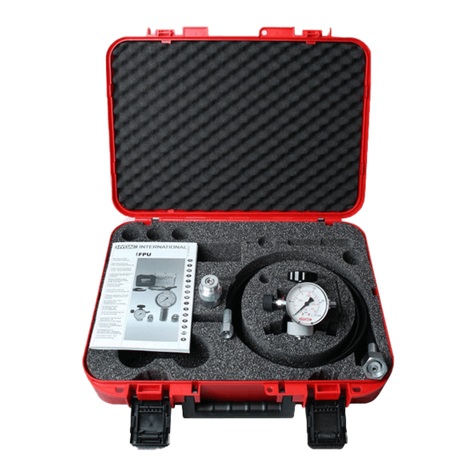
Hydac
Hydac FPU-1 operating manual
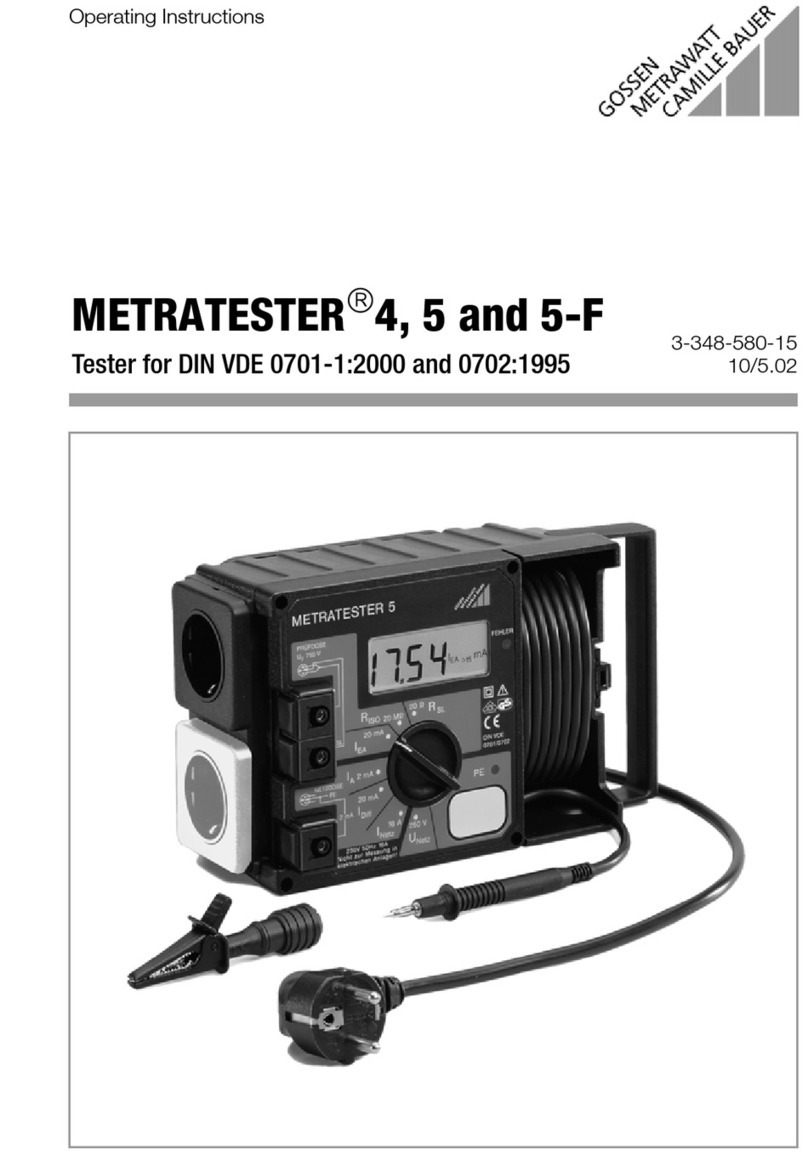
GMC
GMC METRATESTER 4 operating instructions
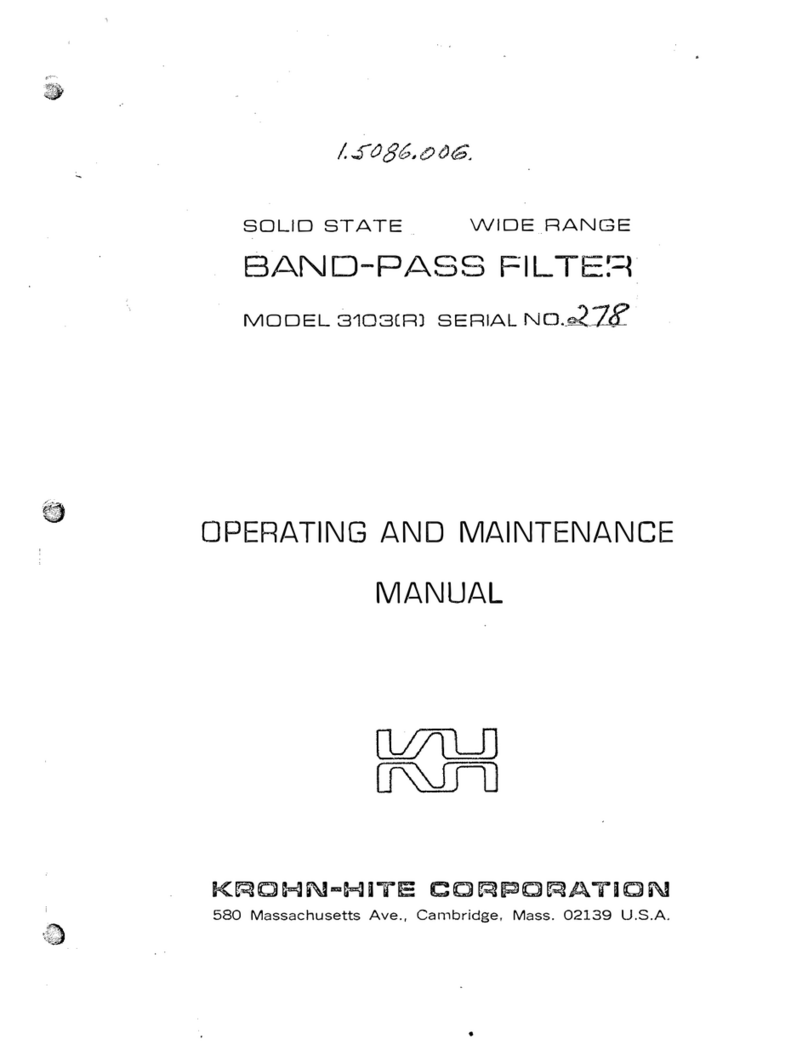
Krohn-Hite
Krohn-Hite 3103 Operating and maintenance manual

anago
anago KST Series operating manual
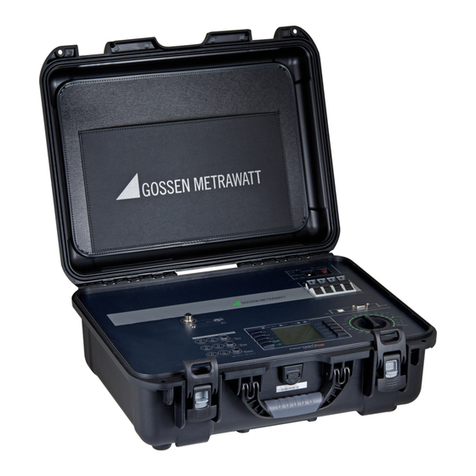
Gossen MetraWatt
Gossen MetraWatt PROFITEST PRIME Short-form operating instructions

Global Leak
Global Leak KLI9210 Operation manual
